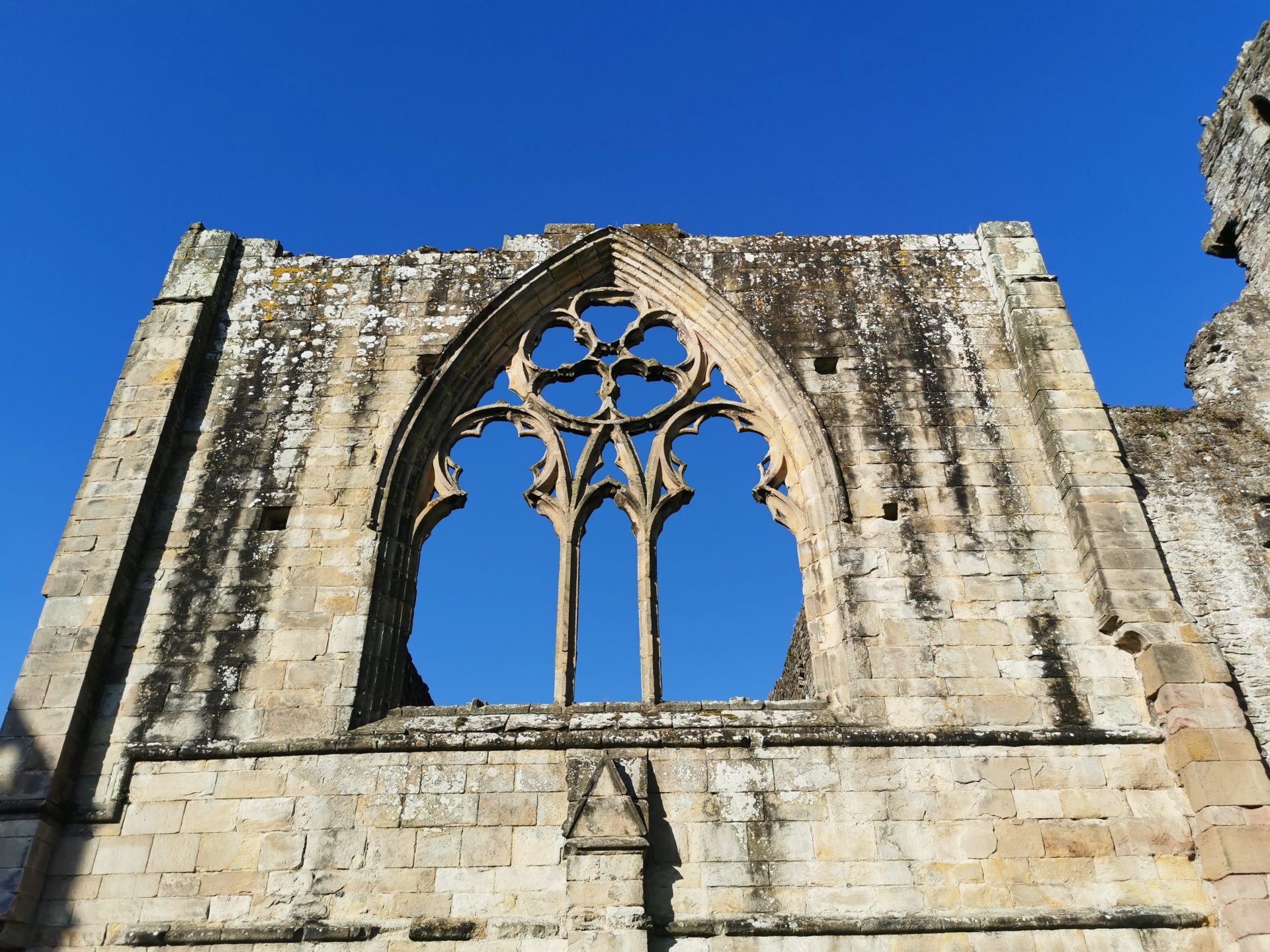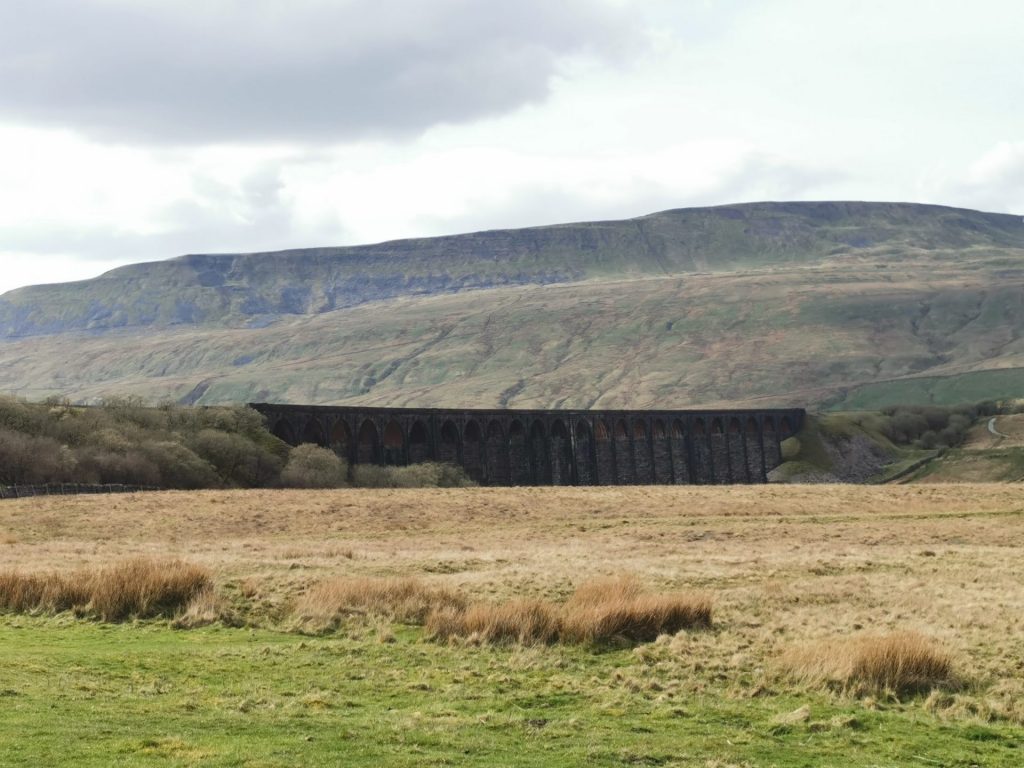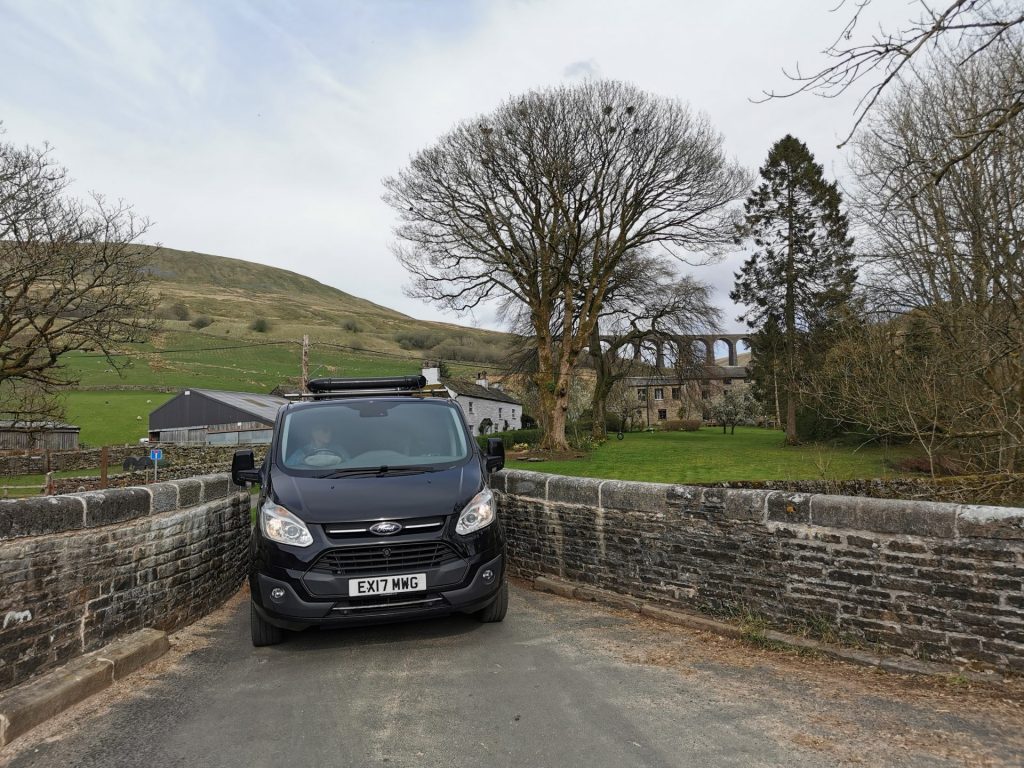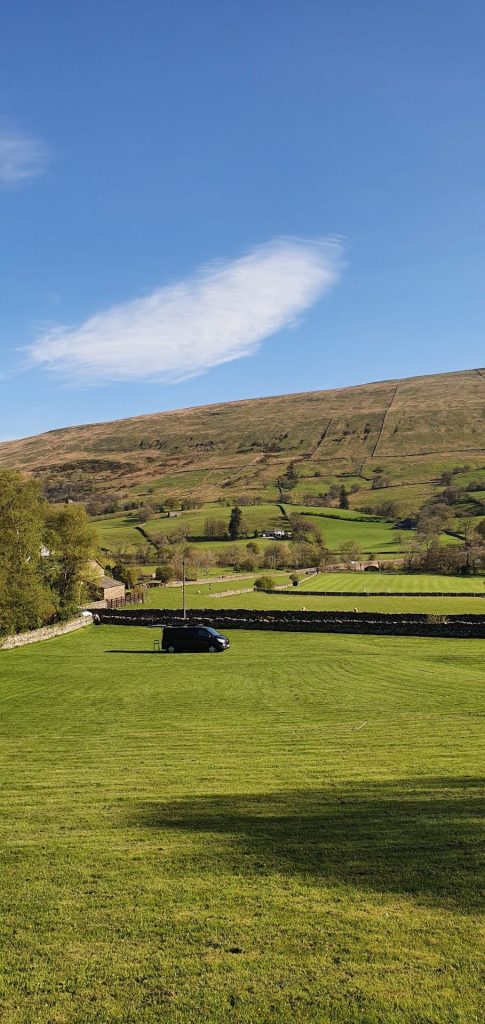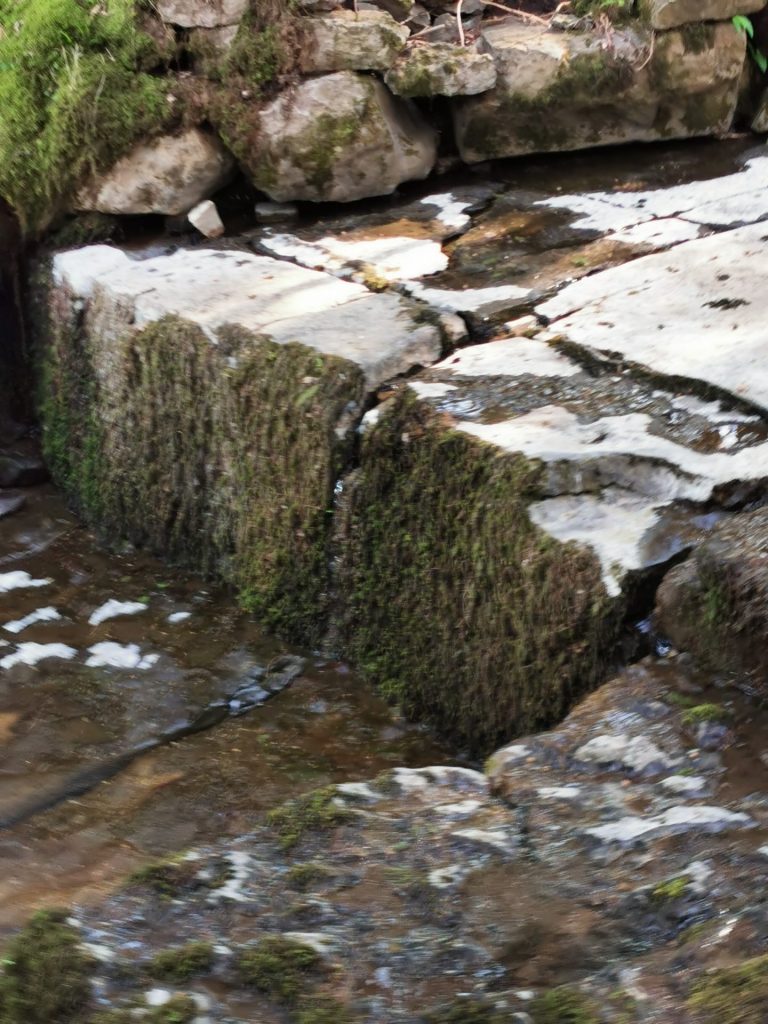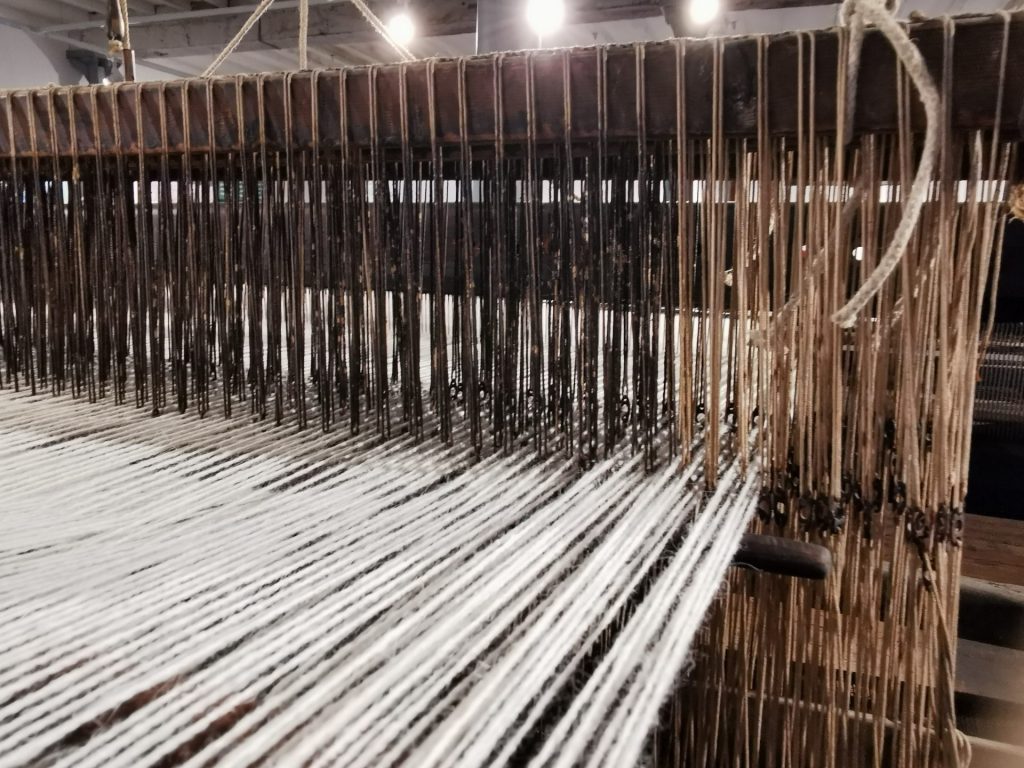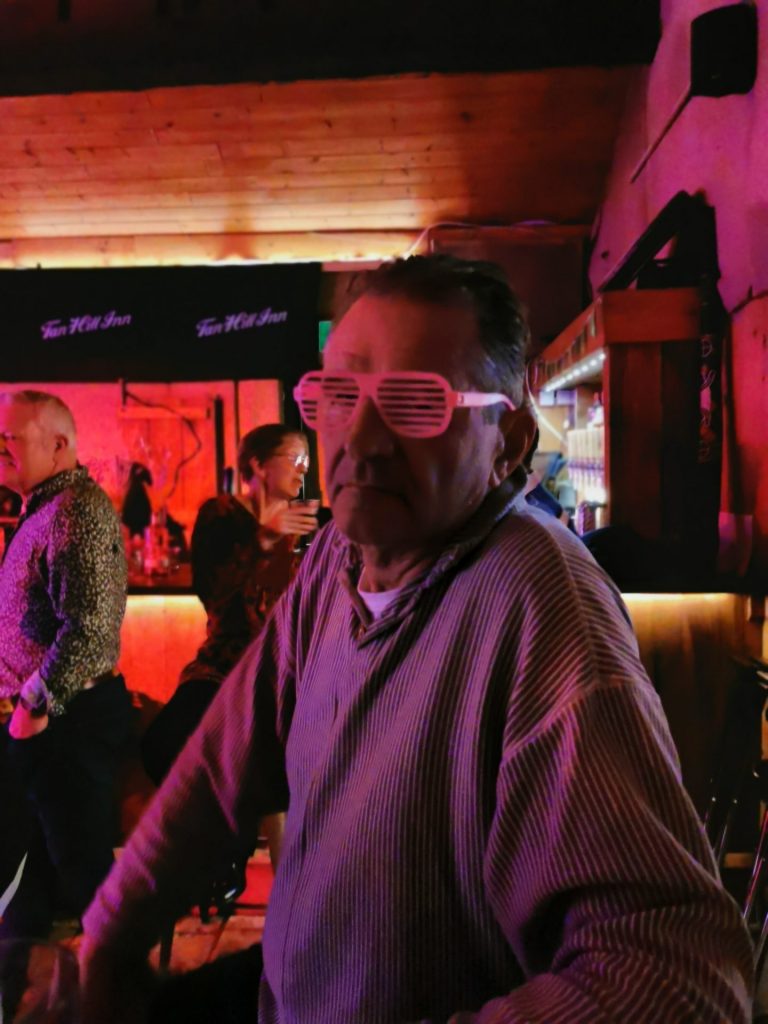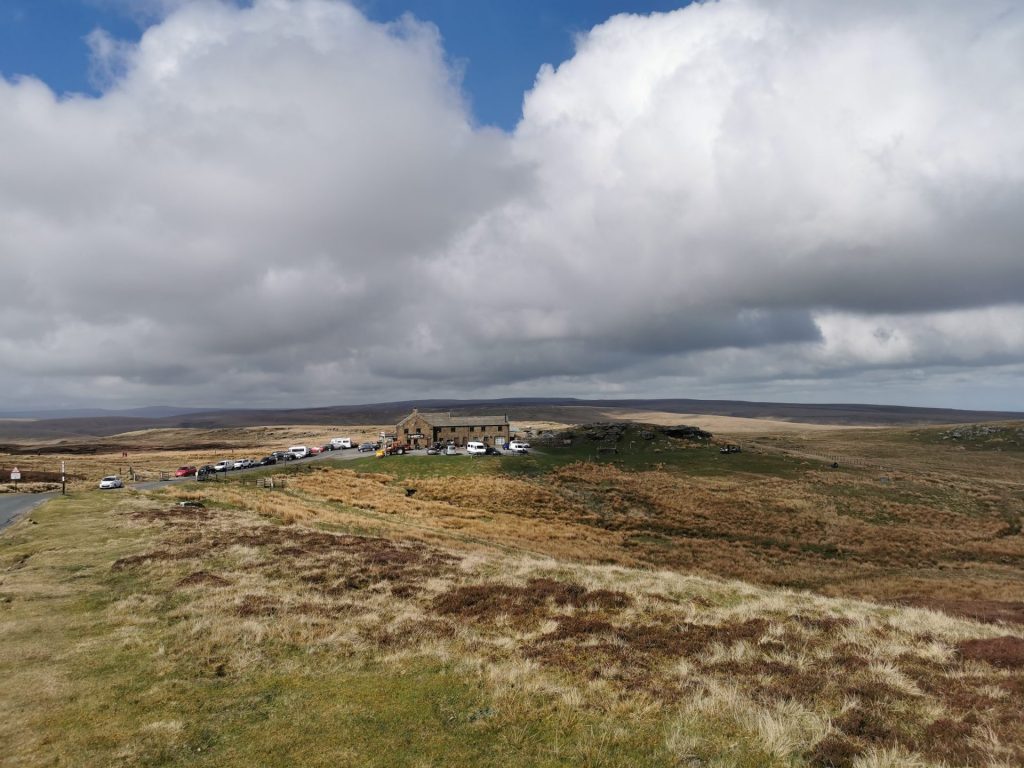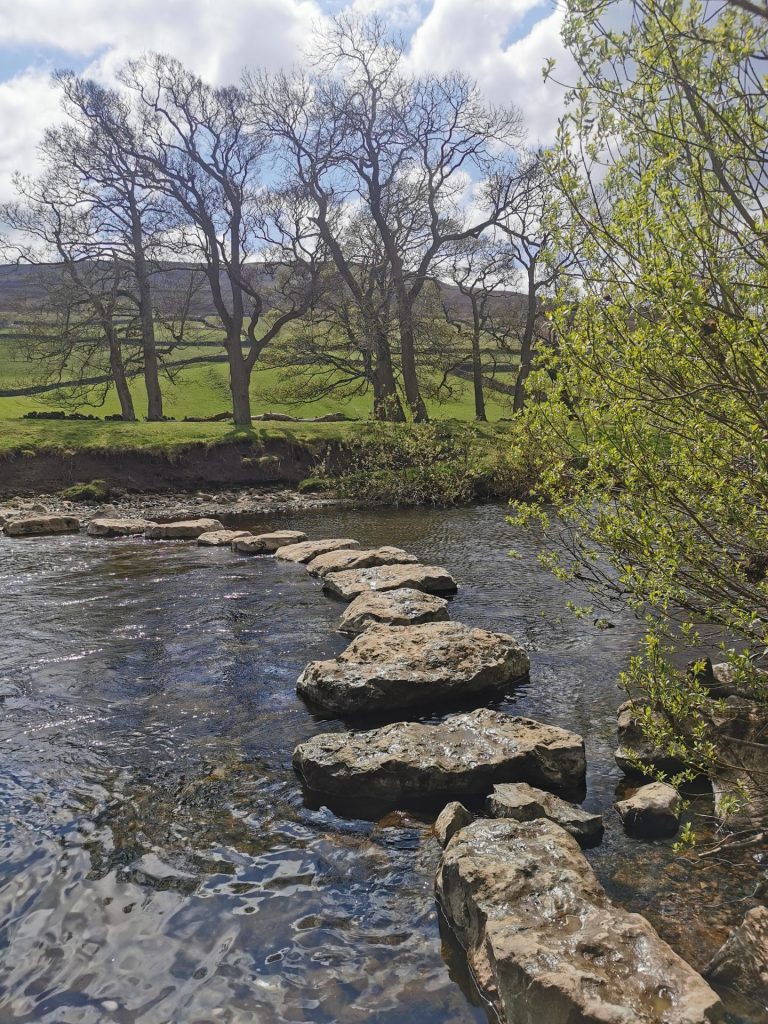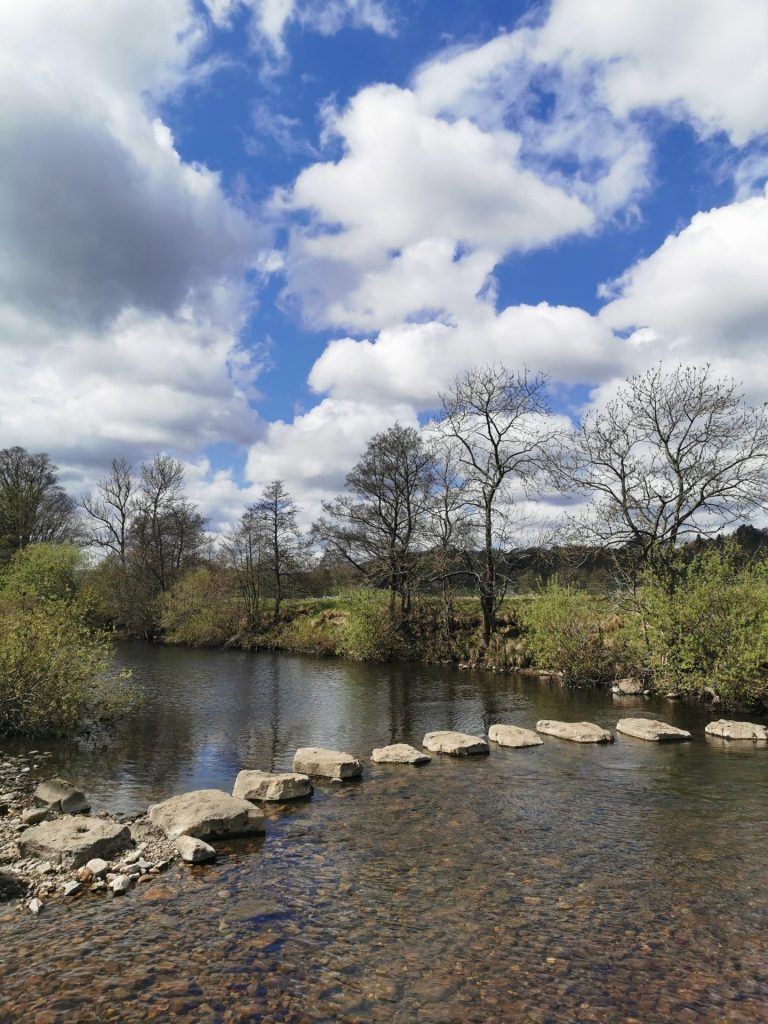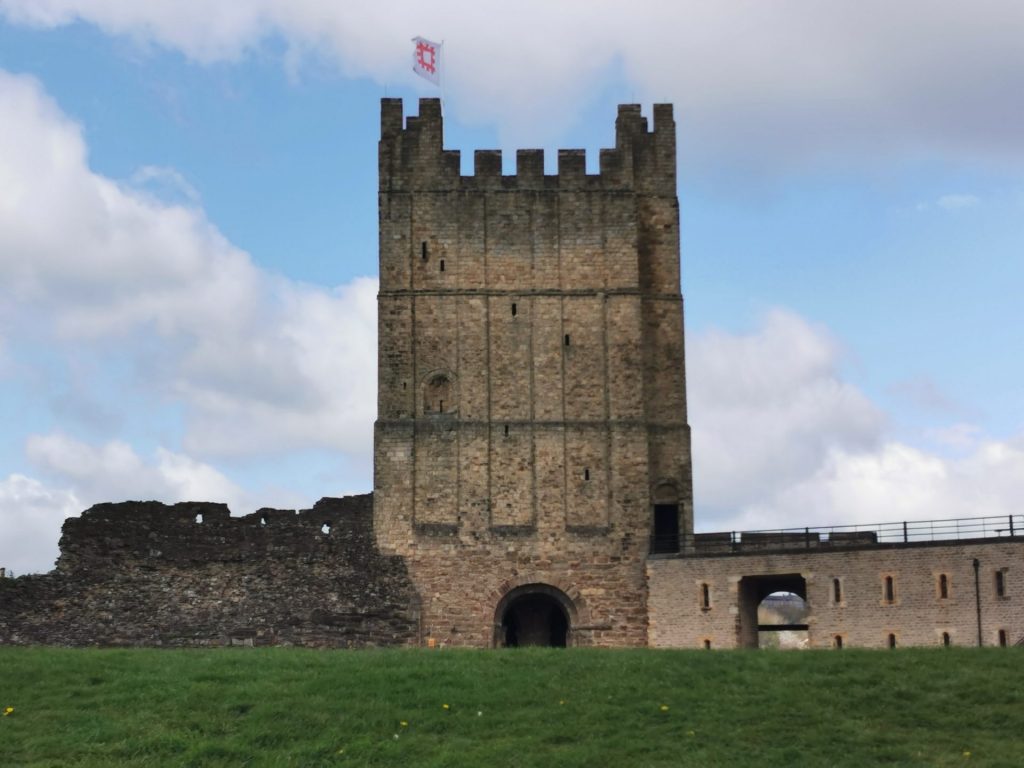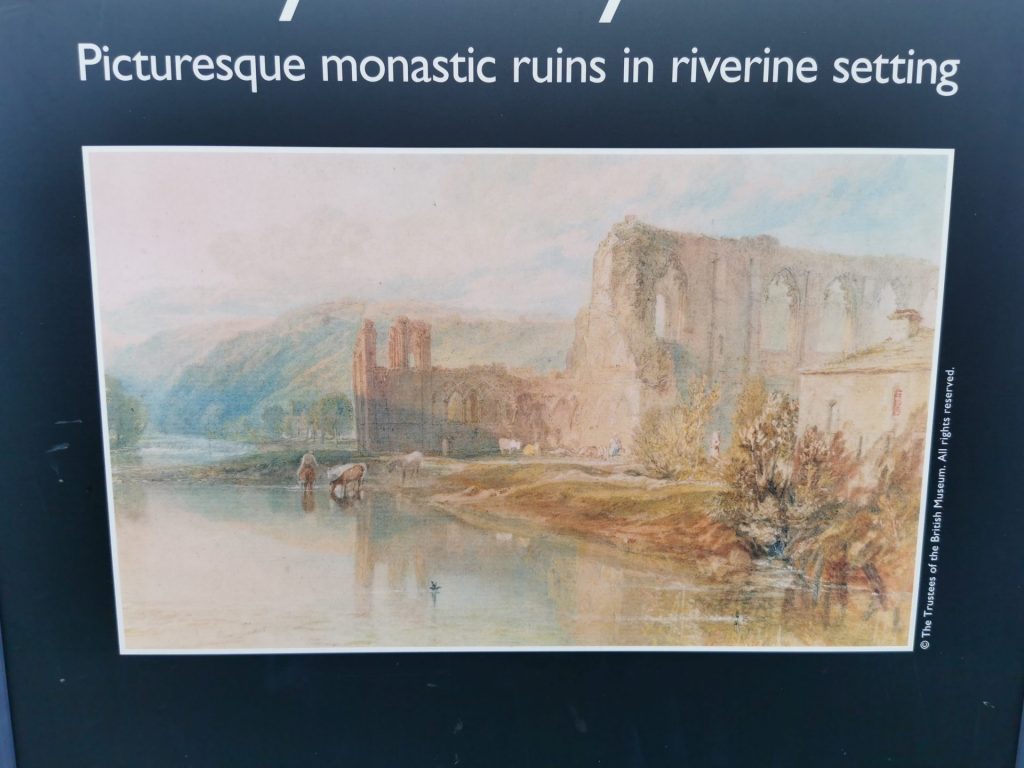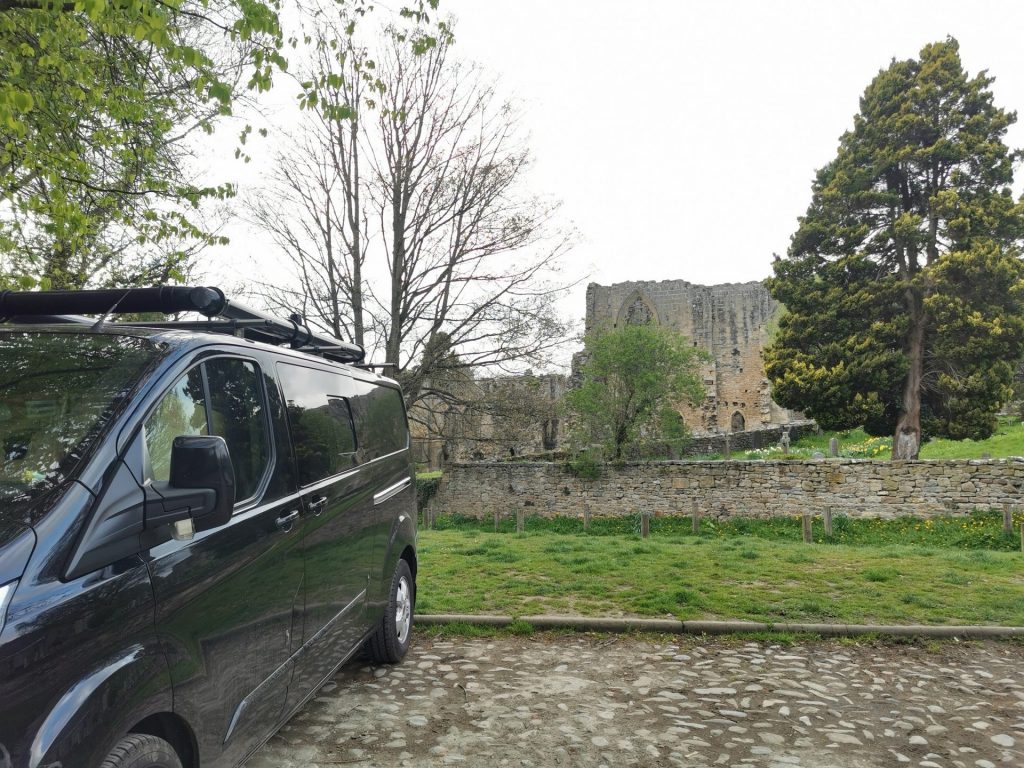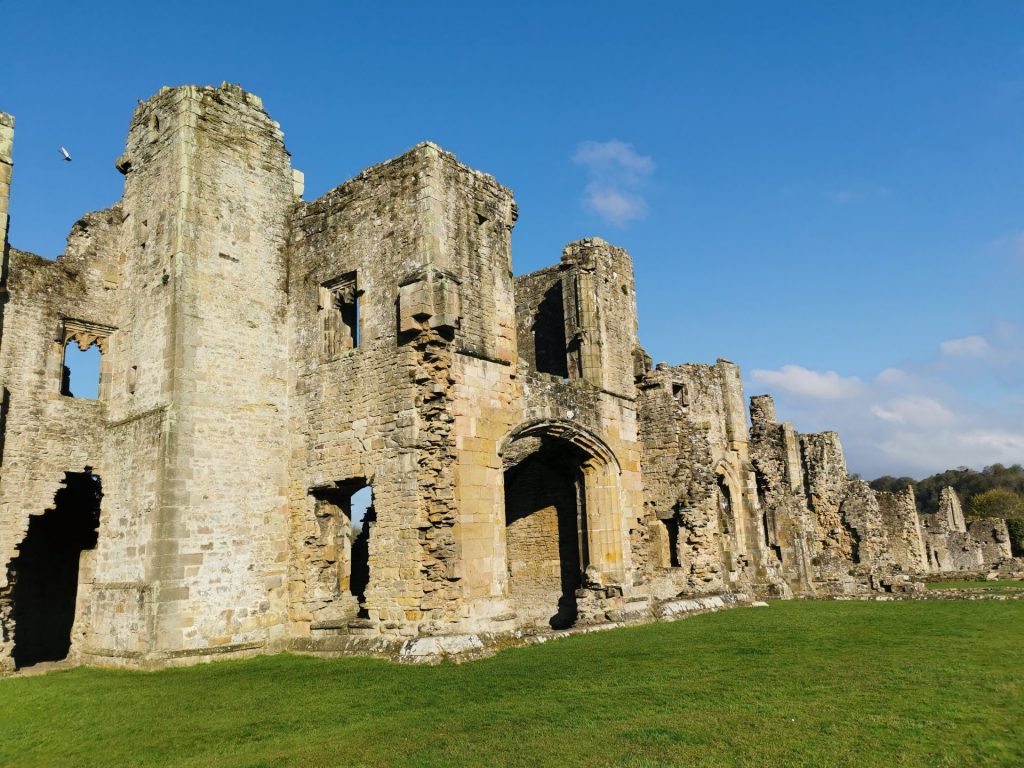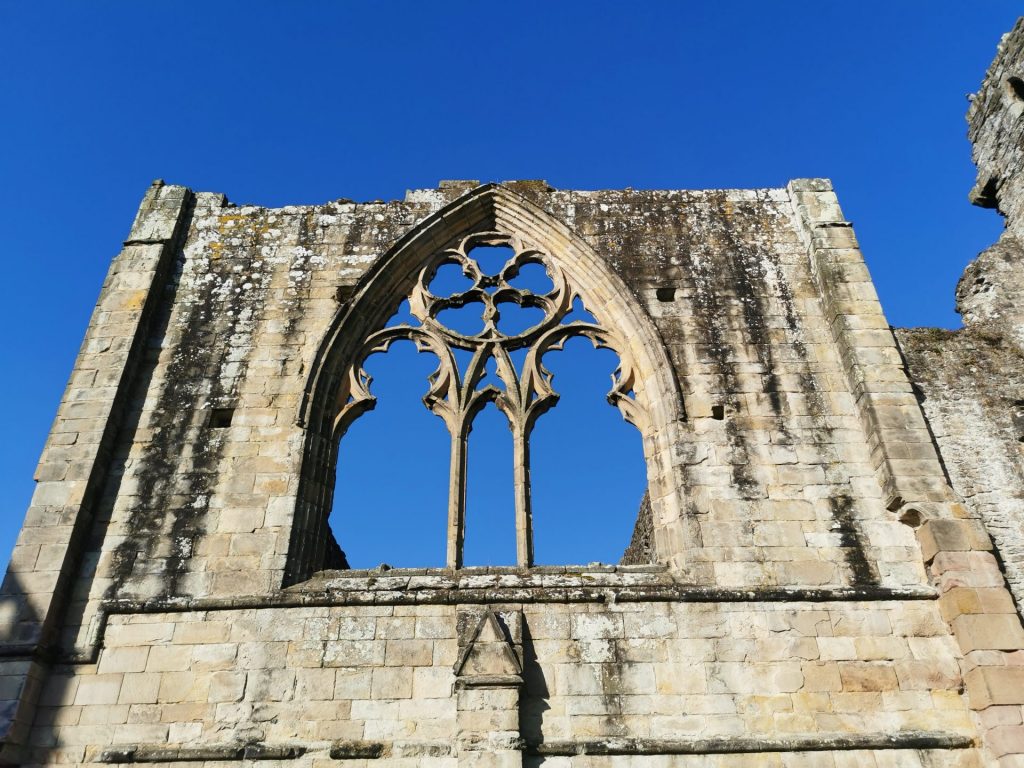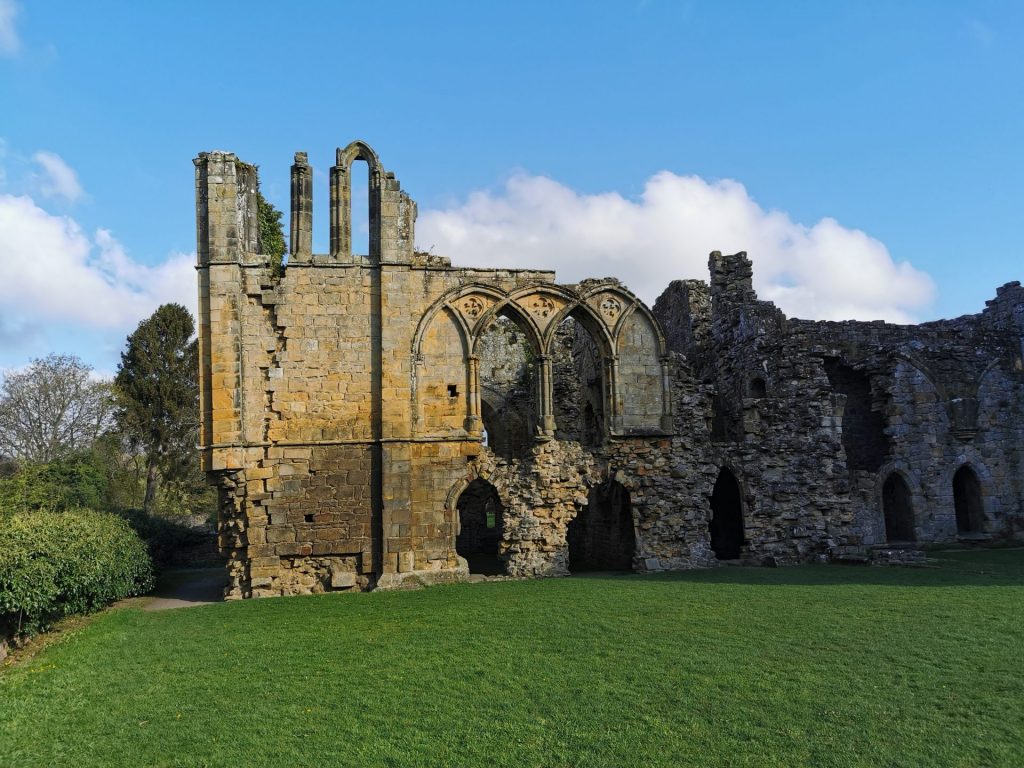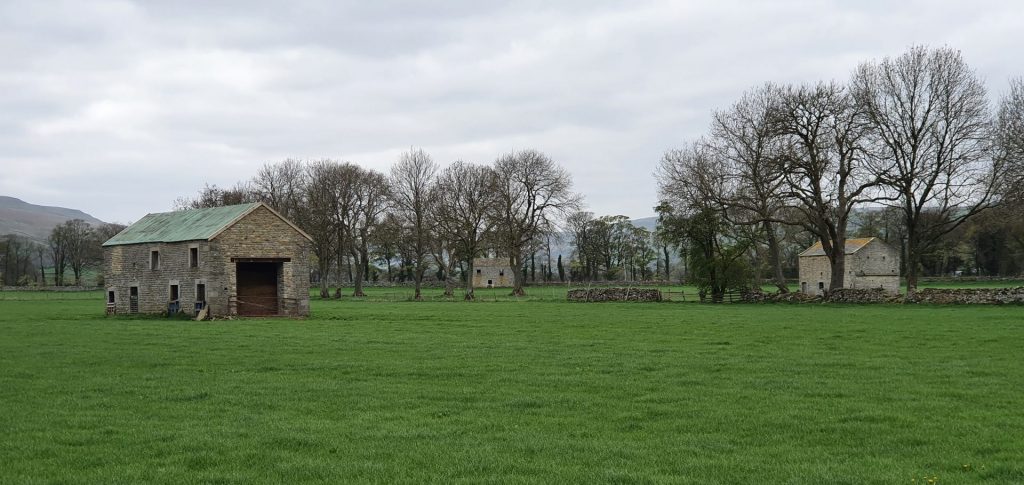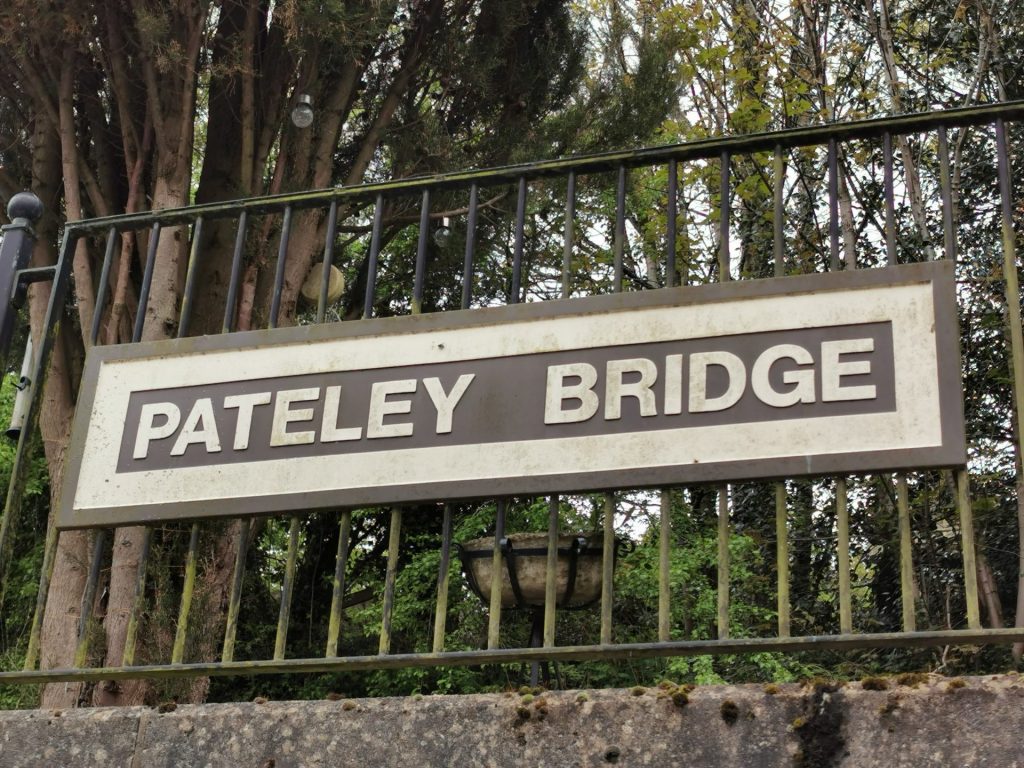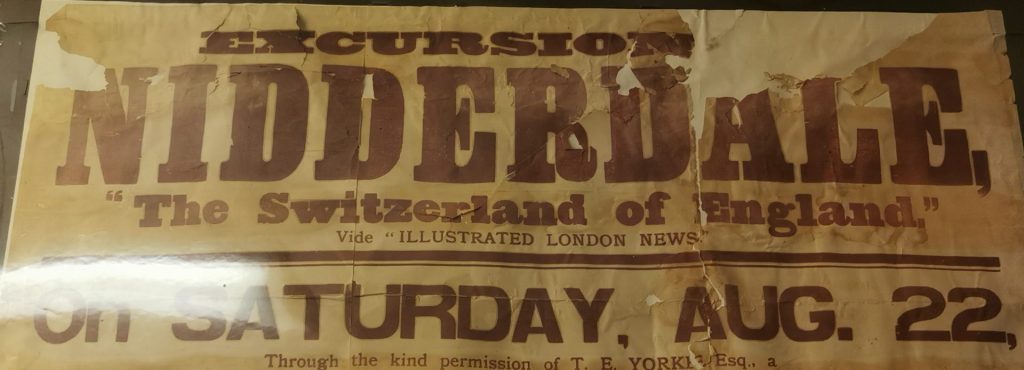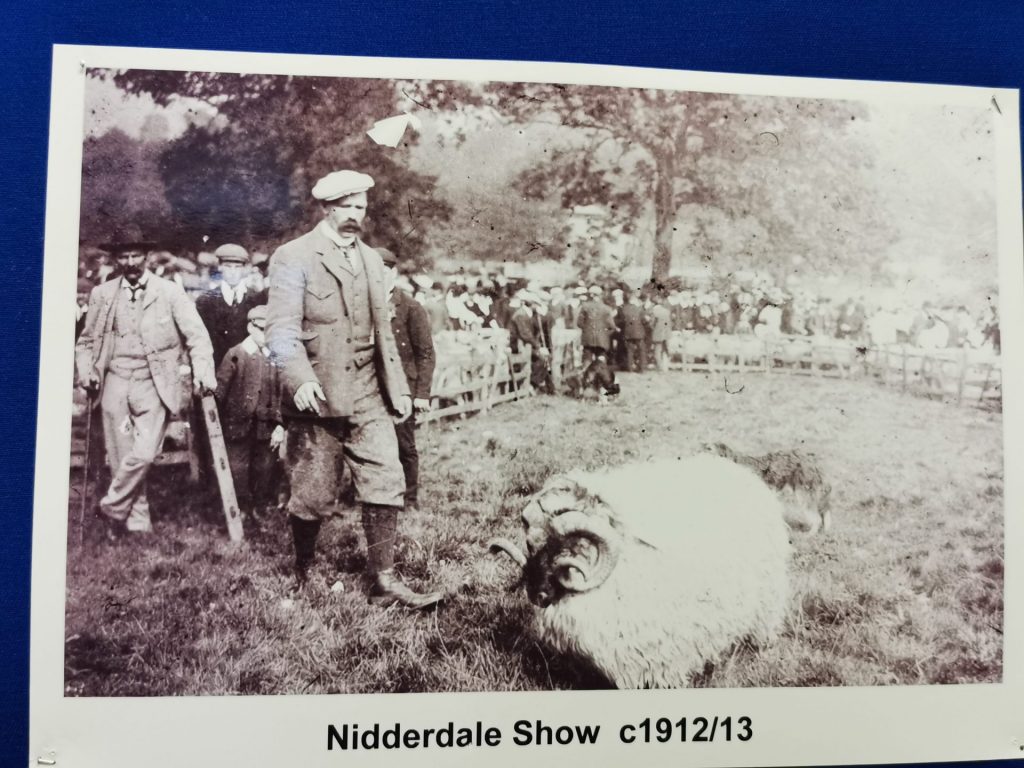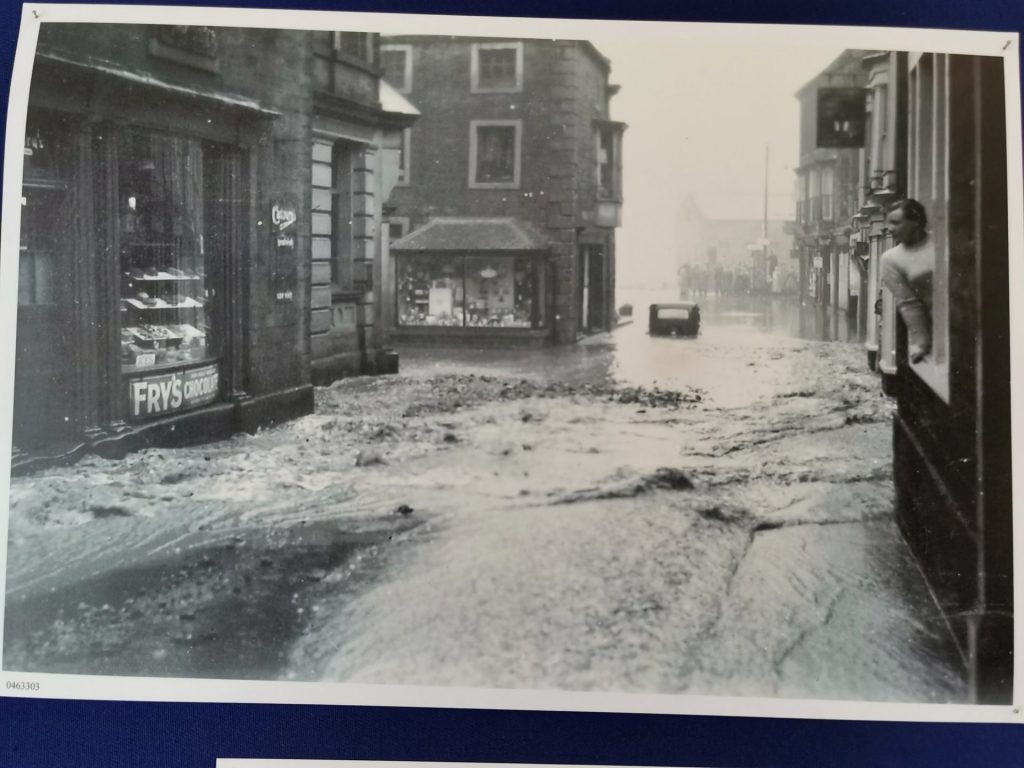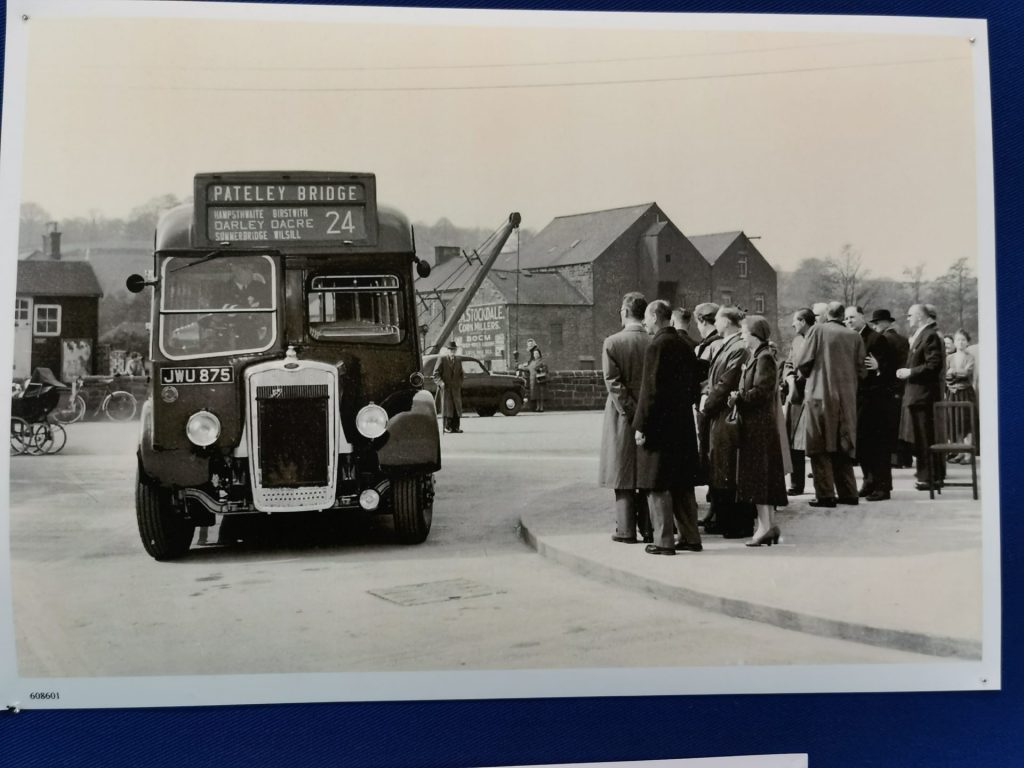I must come clean about Yorkshire. I had some stubbornly ingrained preconceptions, and I was wrong about the place – I had a shaky start. Despite, or perhaps because of that rocky kickoff I’m now really quite taken with my ancestral homeland. The folk, young and old, are very genial and there are fewer of them. People generally seem to respect, and have the time for each other more than down south. The rural and rugged landscape with its many rivers is quite beautiful. I feel it has lots to offer that we have lost in the dog eat dog English Home Counties.
From home in the Nidderdale, North Yorkshire we’ve roughly mapped out a two week campervan scamper around the Yorkshire Dales, mostly in the National Park (size 2,178 sq. km or 841 sq. miles) that will take us through Ribblesdale, Dentdale, Smardale, Ravenstonedale, Swaledale, Arkengarthdale, Wensleydale, Coverdale, Wharfedale and back home to Nidderdale. A journey that, at its farthest extent, takes us no more than a couple of hours away from home. With Jo setting the pace, and planning treks on her OS mapping app we’ll be doing lots of walking.
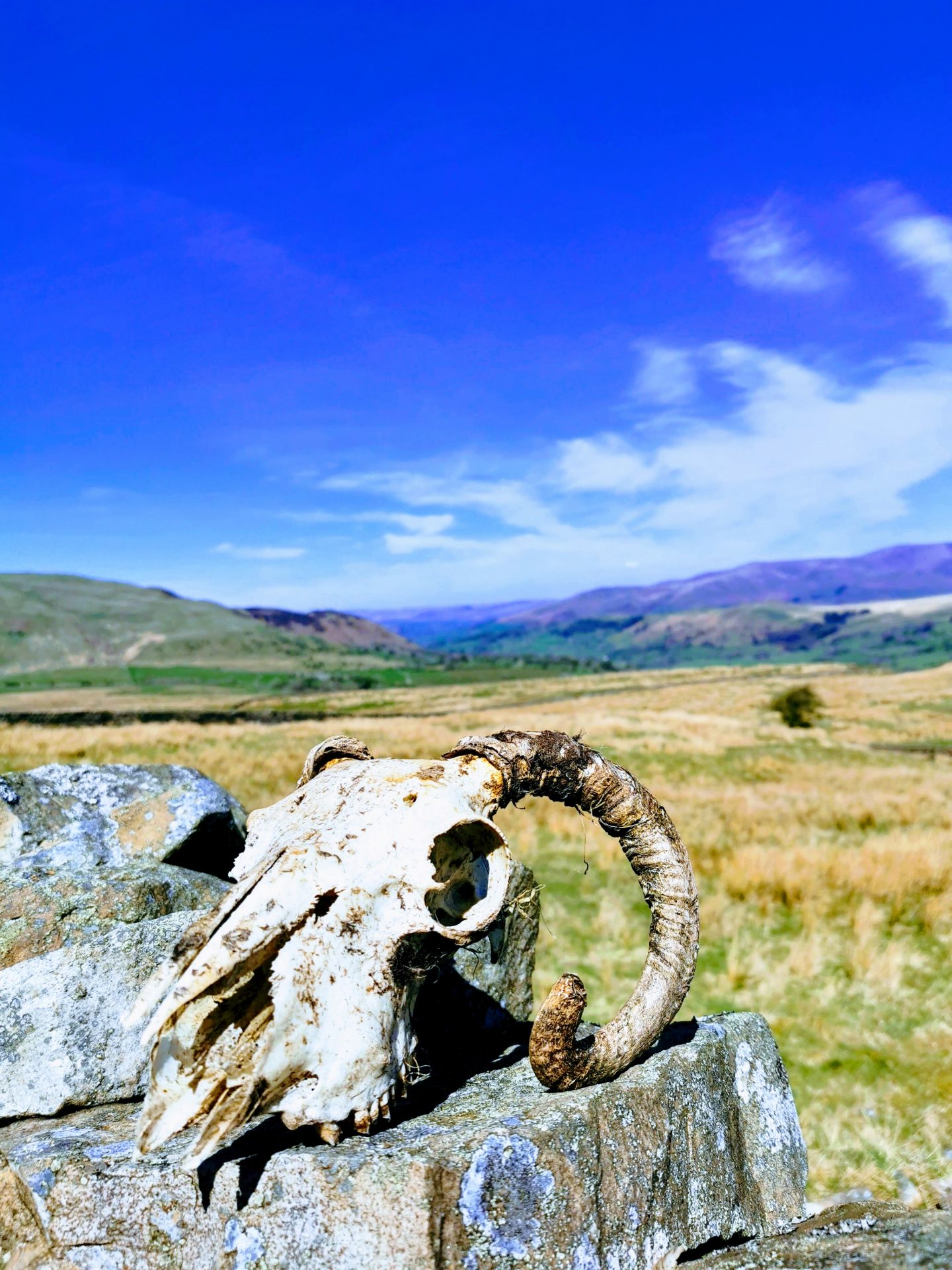
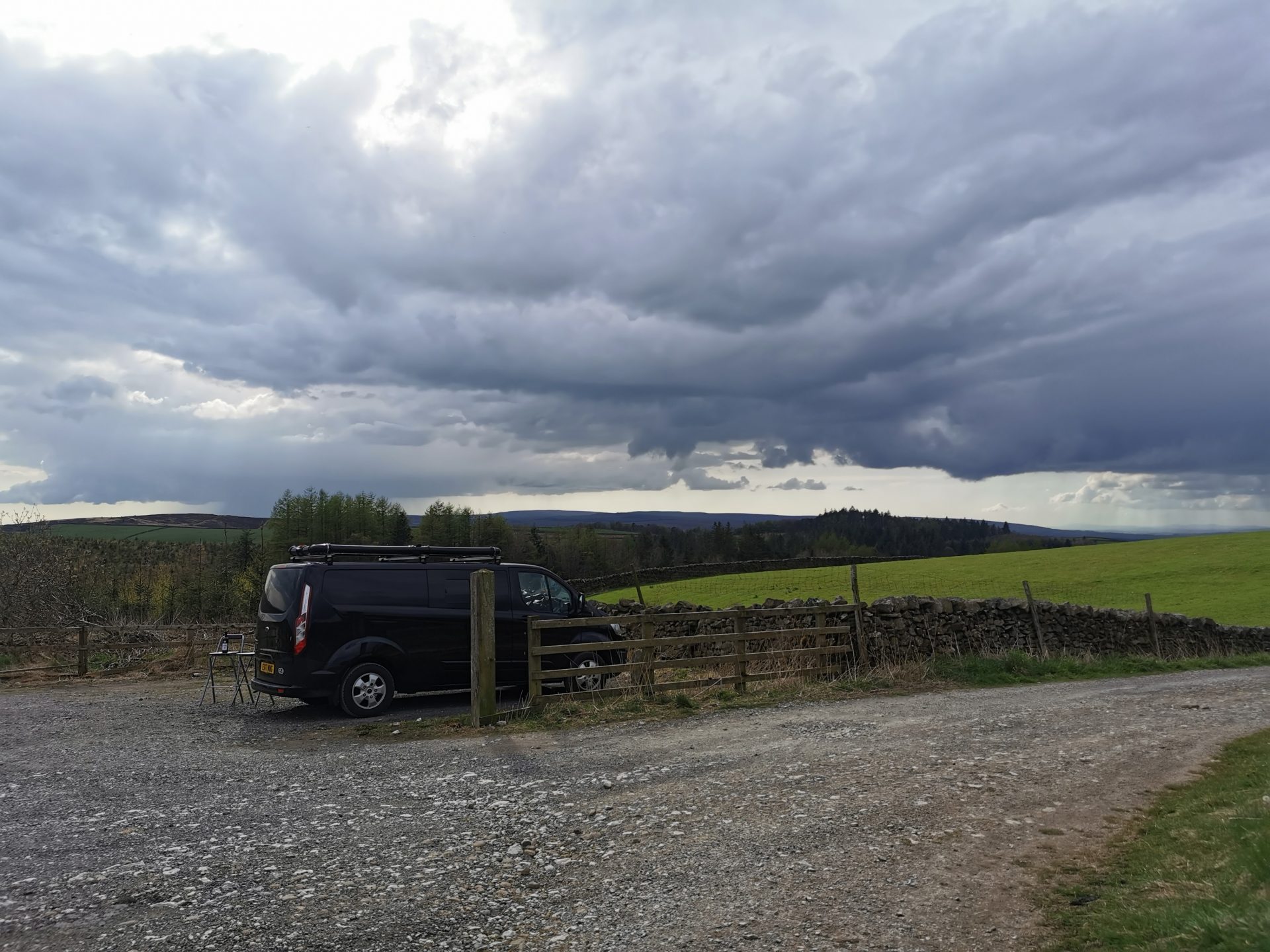
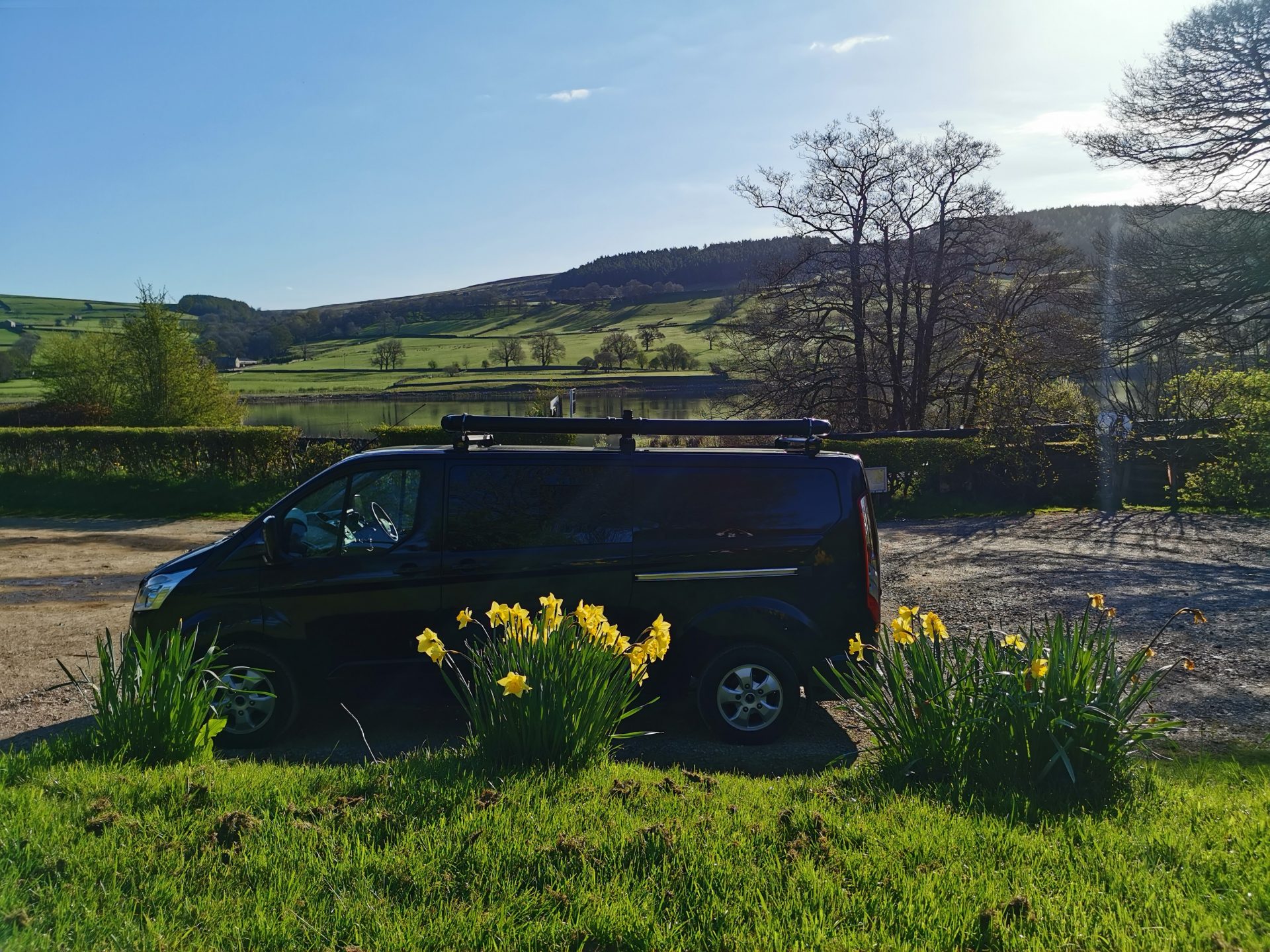
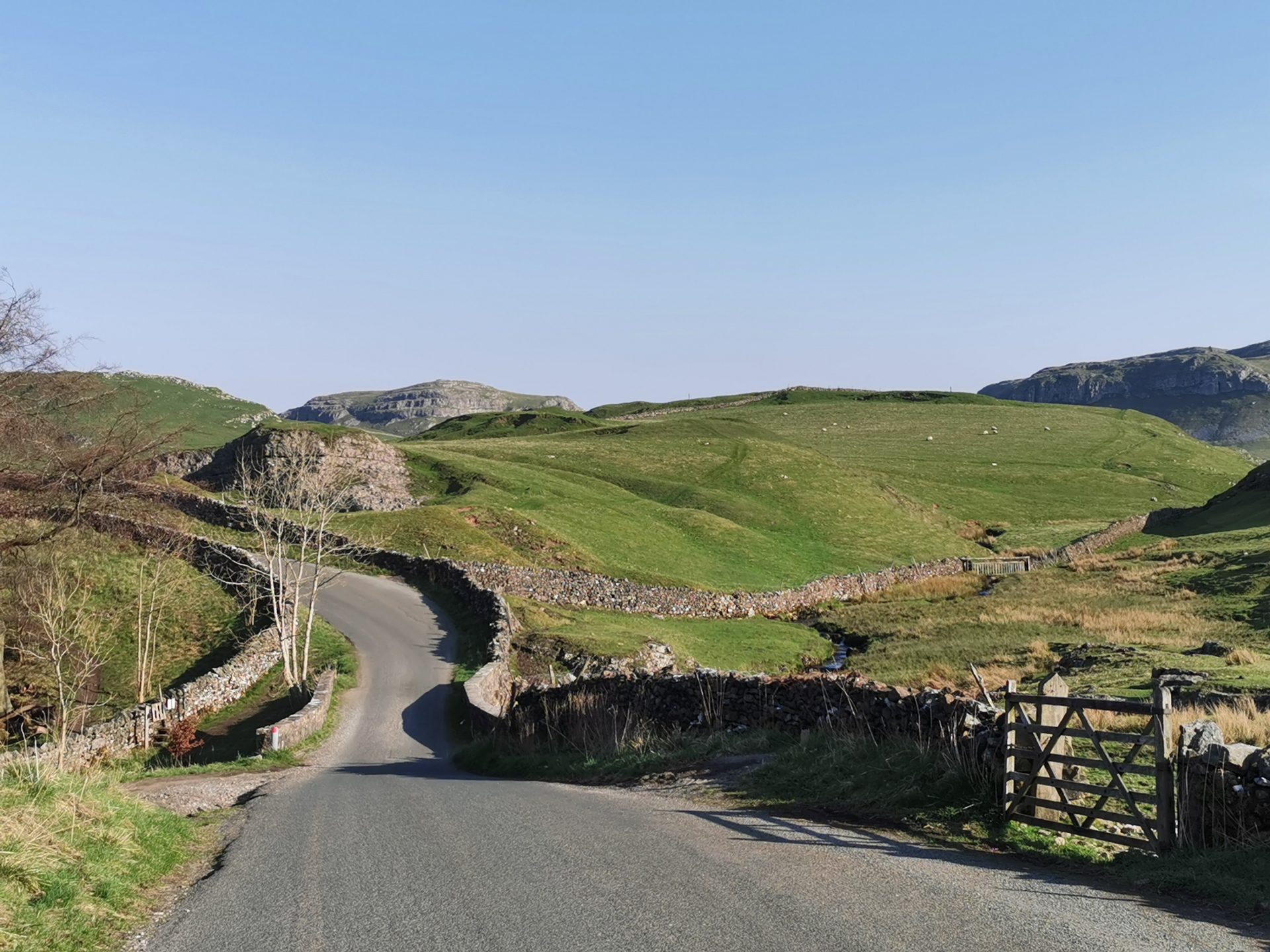
Nidderdale is in the Yorkshire Dales – not in the Yorkshire Dales National Park. This is not because it doesn’t qualify in terms of natural beauty and an abundance of moors, rivers, becks (northern streams), waterfalls, ruined abbeys, nature trails, rocks and peaks. It’s because when the National Park was created in 1954, local District Councils fought to retain their powers in the Nidderdale and refused to cede them to the National Park Authority. Independent lot.
We drive west to Settle and visit its attractive old railway station. This is the southern end of the famous Settle to Carlisle railway line which crosses the remote, scenic regions of the Yorkshire Dales and the North Pennines. We then head northwest to the village of Ingleton and the nearby Ingleton Waterfalls. It’s seldom that we’ll pay for a walk, and at £16 for both of us it isn’t cheap. But the car park is empty and it’s a beautiful morning. We stroll for three hours along a winding path through steep wooded valleys and gorges of the River Twiss and the River Doe which cross what is known as the North Craven Fault via a series of spectacular waterfalls. The guide names five waterfalls but other than Victoria and Niagara, I’m a great one for forgetting waterfall names. Each named waterfall has a number of separate cascades so there are actually many more than five. The walk is worth the money.
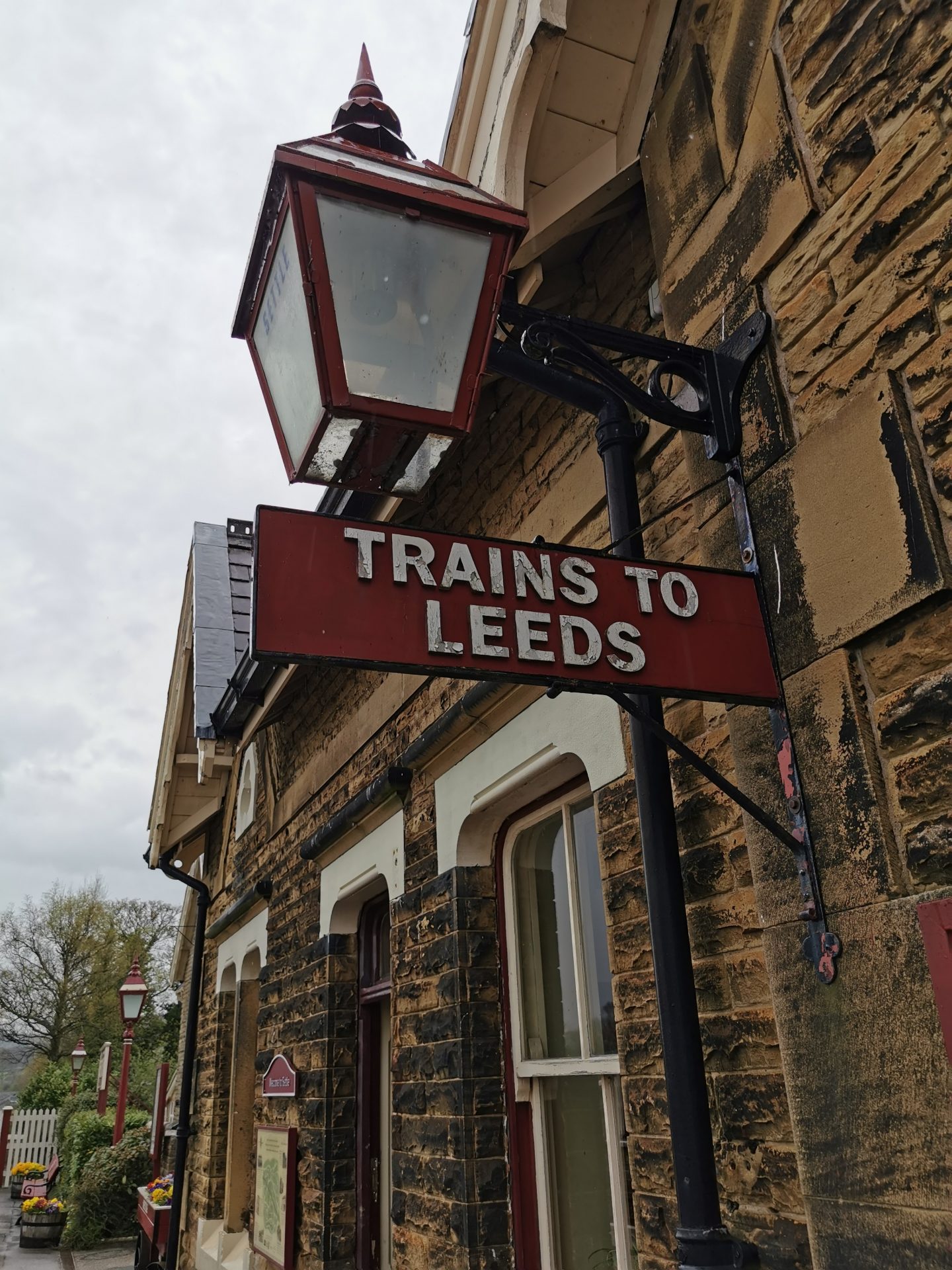
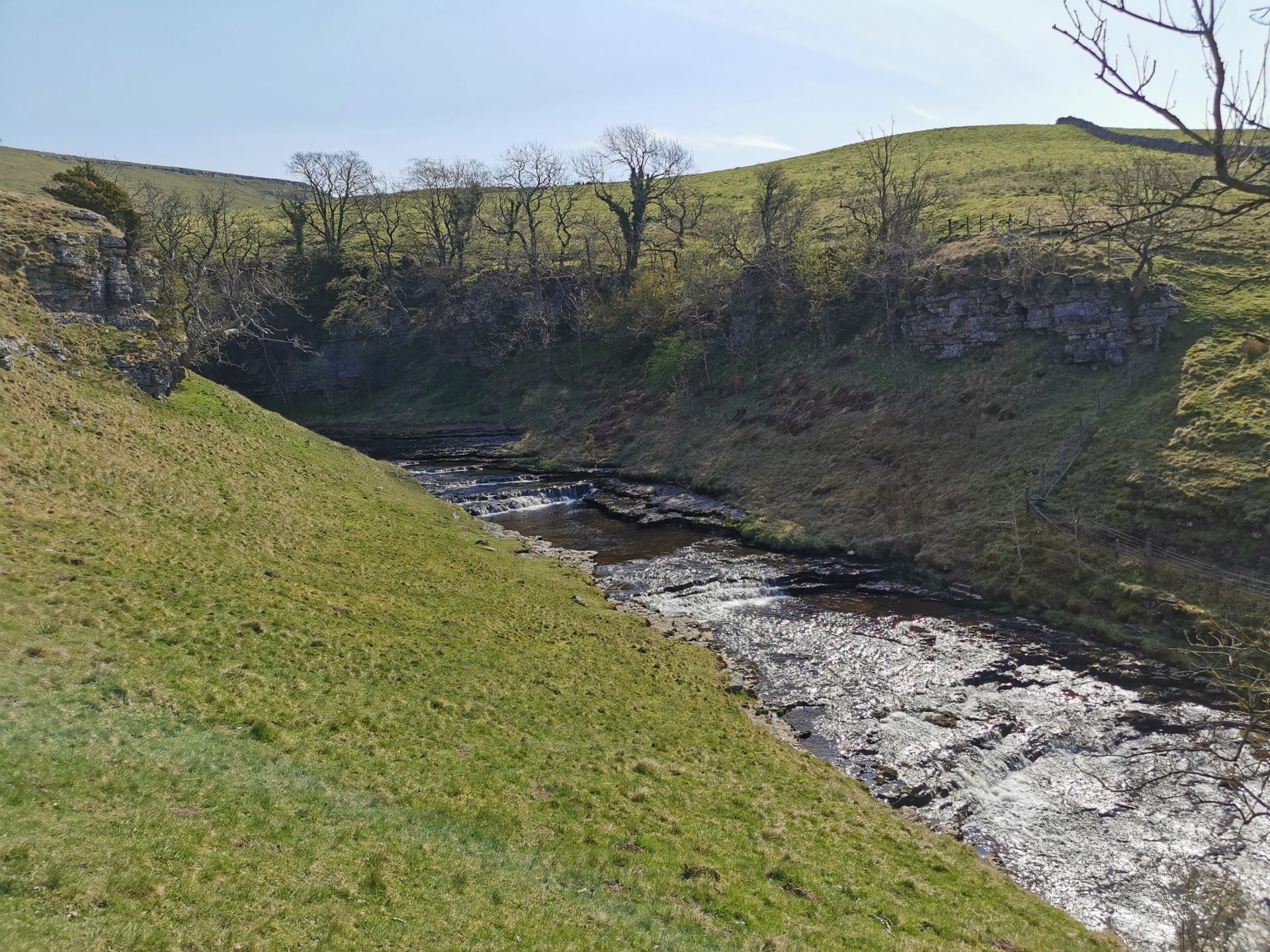
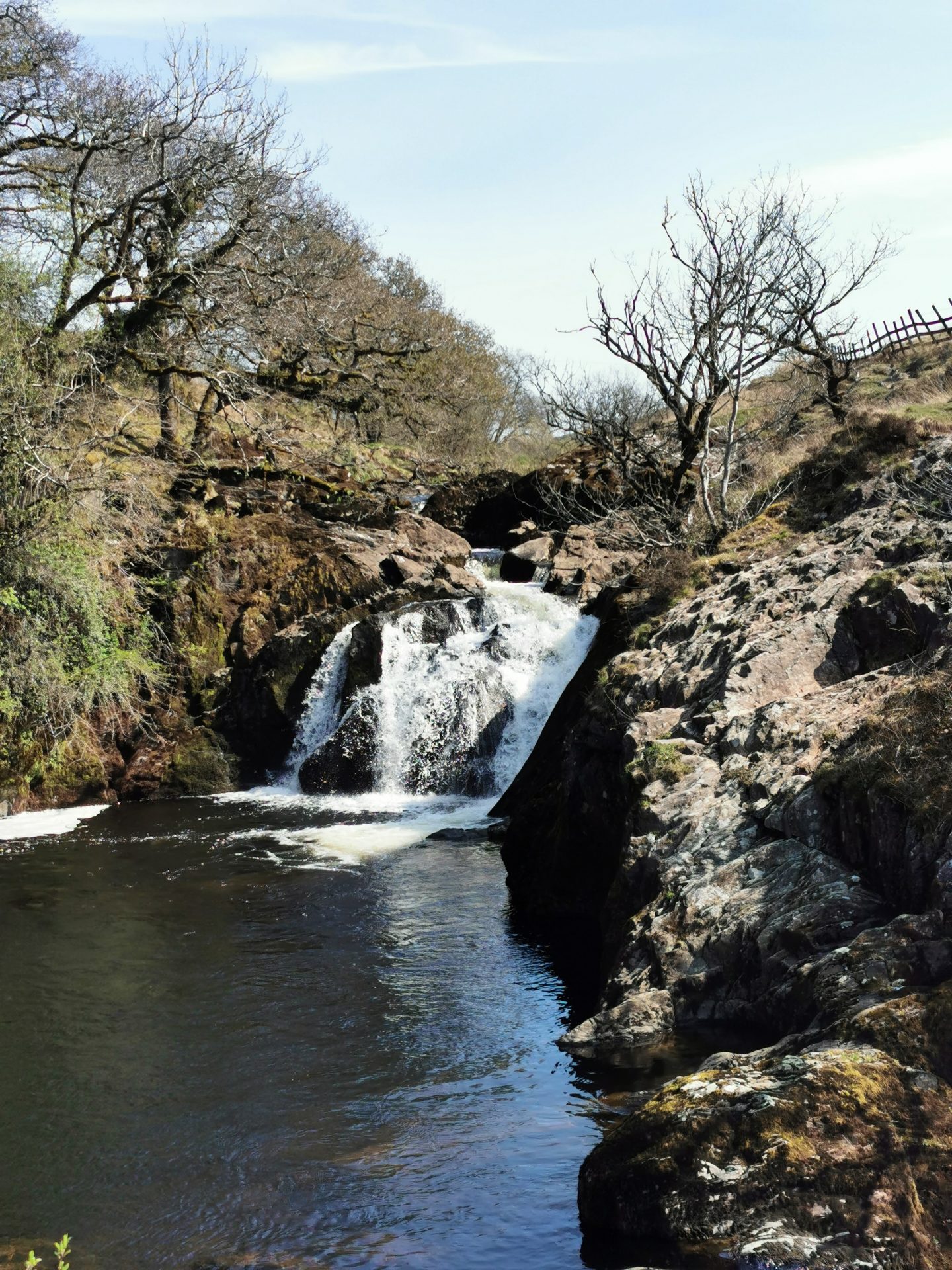
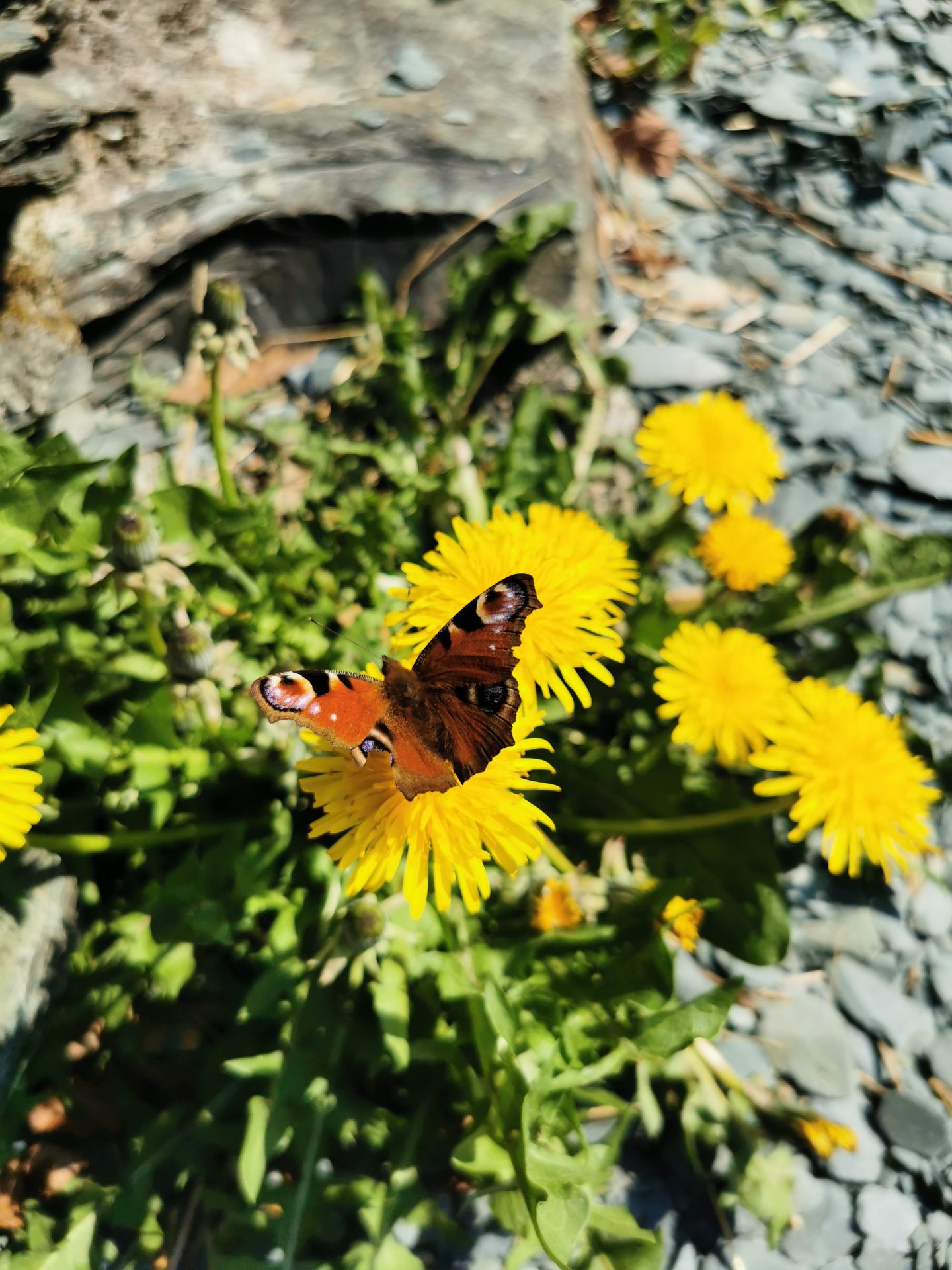
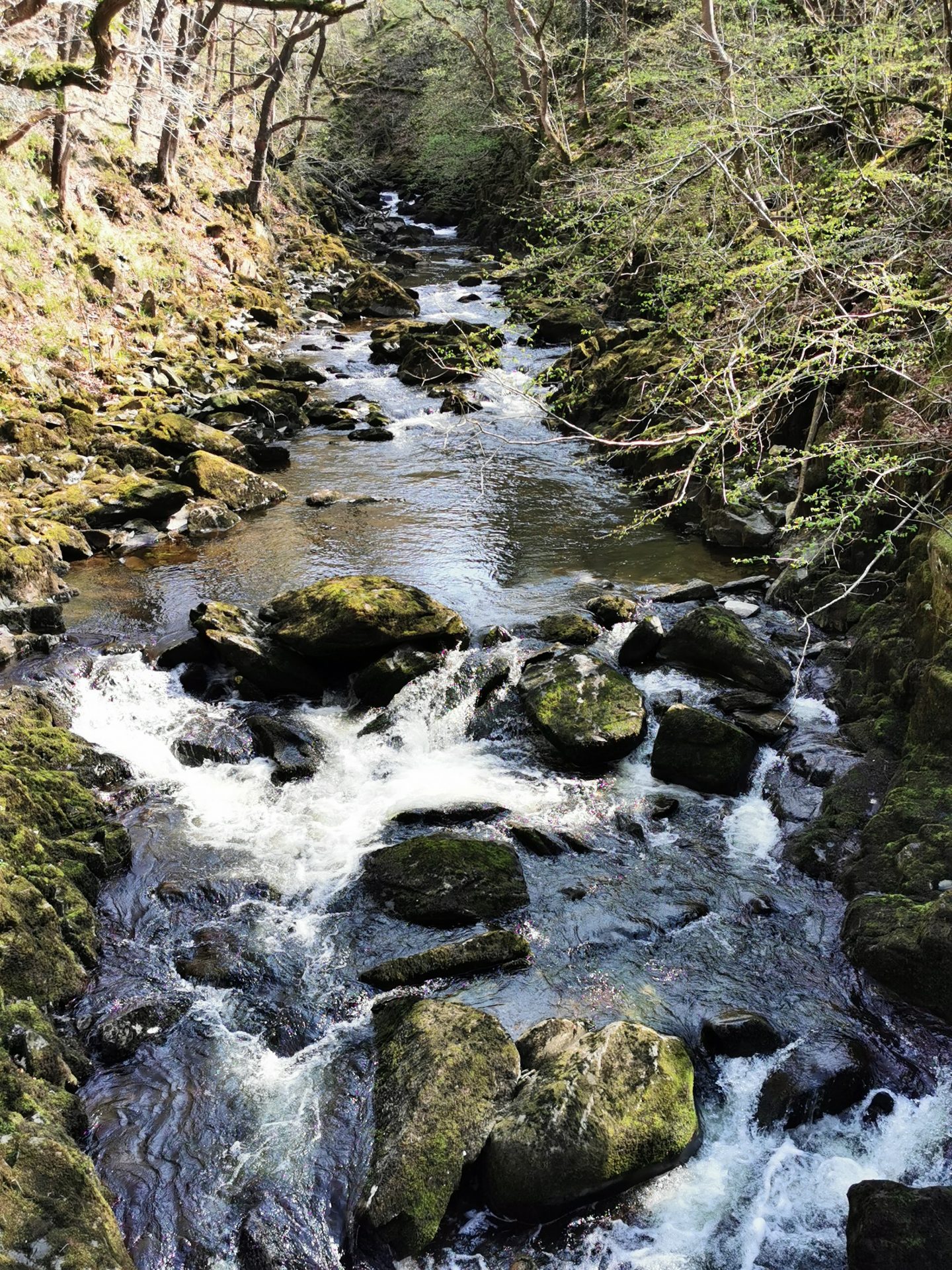
Seven miles northeast is the famous Ribblehead Viaduct which carries the Settle to Carlisle railway line. Opened in 1874, it was constructed by a workforce of over 2,000 men, 100 of which were killed in the process. With 24 arches spanning 400 metres it’s an immense and beautiful structure, much admired by photographers in the right light. But when we turn up it’s cold, grey and overcast – a scene not cheered up by the surrounding bleak moorland and farmland. If you want to appreciate it, get here at dawn or dusk on a sunny day.
We drive into Dentdale along a tiny lane next to a beautiful fast flowing rocky beck – at the beginning of which is a sign stating no entry for vehicles wider than 6 feet – that’s less than 2 metres. The van is just over 2 metres by we give it a go. It’s a tight squeeze between the stone walls of a tiny humpback bridge into the village of Dent. What a lovely surprise – Dent is an unlikely looking Dales hamlet – more reminiscent of Cornwall with narrow cobblestone streets and tiny whitewashed cottages. Alfred Wainwright, the famous British fell walker, guidebook author and illustrator said in his ‘Pennine Journey’ that “Dent is not of this world. It’s a fairy tale – a place of cobbles, jutting gables, overhanging roofs, quaint alleys, wooden galleries and outside staircases”.
We are still in the Yorkshire Dales National Park but not in Yorkshire! We’re in Cumbria. Which county? Which shire? Which Dale (there are minor Dales within major ones)? I will get steadily more confused by these questions as the days pass – to the point where I won’t trouble myself about it very much. Dentdale is a long, lush, steep sided valley rising to rolling moorland. We book for one night at a cheap (£7 a head, cash only, no change, so £15) campsite with fantastic views of the surrounding hills.
Our walk today is a circular seven mile hike that will take us along part of the Dales Way by the river Dee. But right at the outset I step onto a wet stone slab on a hillside stream (delightfully named Dancing Flags). My feet slide from under me and I crash down hard on my right elbow and leg – break dancing! So it’s back to the van for first aid; blood mopping and steri strips. I’m sore but more than that, I’m frustrated. I’ve had a few of what Jo describes as tumbles over the last ten years, none of them serious but all of them bring me down to earth. These incidents are largely unforeseeable so there’s not much that I can do to prevent them (Jo, in fairness would disagree, foolhardy she’d say). Afterwards I do feel a bit vulnerable and I take things slower and more cautiously for a while. Jo says I’m lucky not to break my hip and be out of action for months. That thought slows me down for a while too.
Despite this, the walk is a great climb through woodland onto the open moors with great views of the high fells. Then a descent to the river Dee through densely populated fields of Swaledale lambs, back to Dent. There are thousands of new born lambs in the Dales in the Spring and Jo wants a decent frontal photograph of a matching pair. So she’s got scores of images of lambs running away and hiding. What she calls the money shot eludes her. I admire her tenacity.

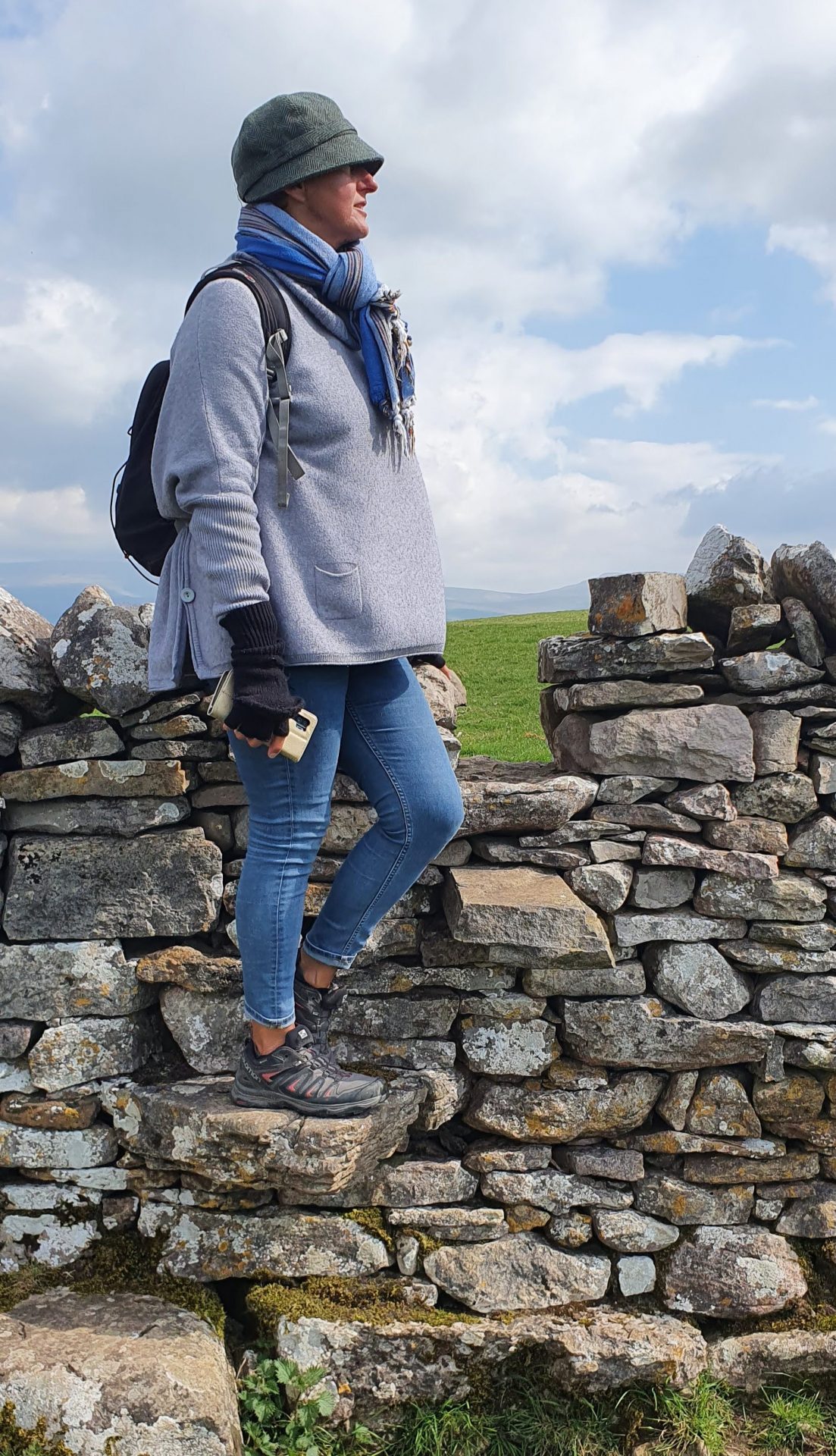
After the walk we use the campsite shower facilities. This is when we realise that you get what you pay for. The shower/toilet shed looks like it was carelessly cleaned twenty years ago and is home to cockroaches and some kind of leech. Jo has done a fantastic job patching up my bloodied elbow but it’s a devilish job to shower in this grim hut without getting it dirty or wet. Despite this I’m quite happy, the location of this campsite is fabulous.
The following day we drive to the town of Sedbergh (again in the Yorkshire Dales, but actually another Cumbrian town). It’s dominated by the assorted buildings of a fine looking independent school, the pupils of which wear a smart tweed jacketed uniform. The narrow old High Street is dotted with bookshops (the town recently reinvented itself as a northern Hay on Wye book town) and retailers of country attire and Yorkshire fare. We buy a book of Yorkshire verse and a short history of the River Nidd. We visit the partially restored Fairfield Mill (not as nice as my mill says Jo). It houses arts and crafts studios, a café, a number of looms and an old turbine. Jo spends some time sorting through lamp stands crafted from wooden spindles and bobbins, but she can’t decide on a purchase. We take a short stroll along the boulder strewn river Clough.
The road north from Sedbergh through Garsdale is beautiful but it’s not taking us anywhere we want to go today.

In Smardale, it’s another lovely day. We walk nine miles, partially on Wainwright’s coast to coast trail and along a disused railway track over a splendid viaduct that once held the railway for the local limestone quarry. At the quarry, next to the dismantled railway line are a couple of wonderfully preserved lime kilns. Limestone was probably first burnt in England by the Romans to provide the lime mortar for building. In the late 17th century its use became widespread when increased prosperity led to the building of local stone farmhouses and barns. The lime was made in small field kilns, and there are the remains of over 300 in this district alone. Later, towards the end of the 18th century, burnt lime began to be used extensively for arable crops and to improve the quality of pasture land. Later still, burnt lime was produced on a much larger scale for industrial purposes. These two Smardale kilns represent an interesting stage between the small field kilns, providing lime for local use, and the great industrial lime works of Horton and Langcliffe.
We’re surrounded by grass verges and fields resplendent with enormous dandelions. Ravenstonedale town is charming with two good pubs. We have coffee, and use the very decent toilet in the Swan (hairdryer and toiletries!), and after our hike, a pint outside The Kings Head, by the river.

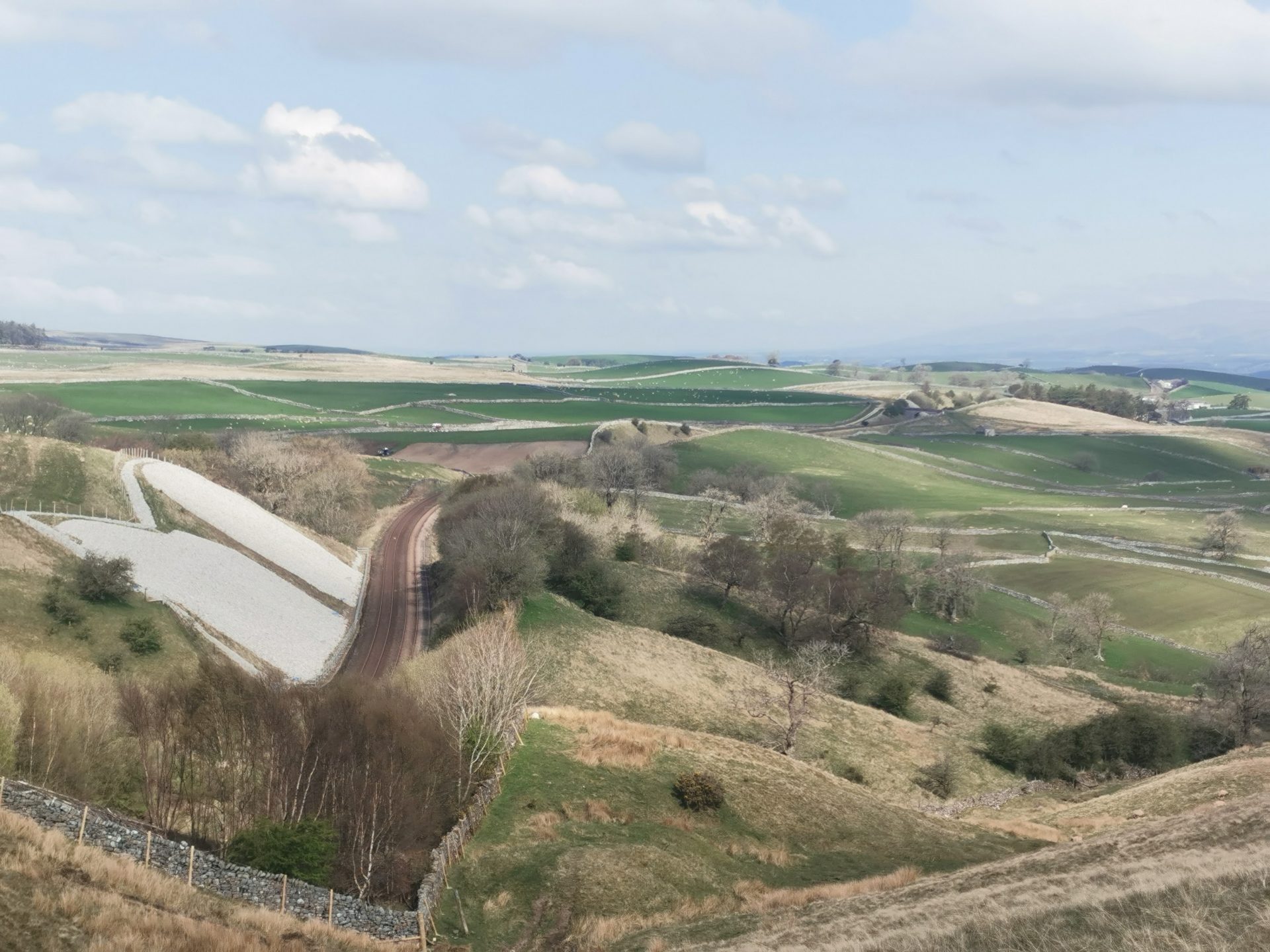
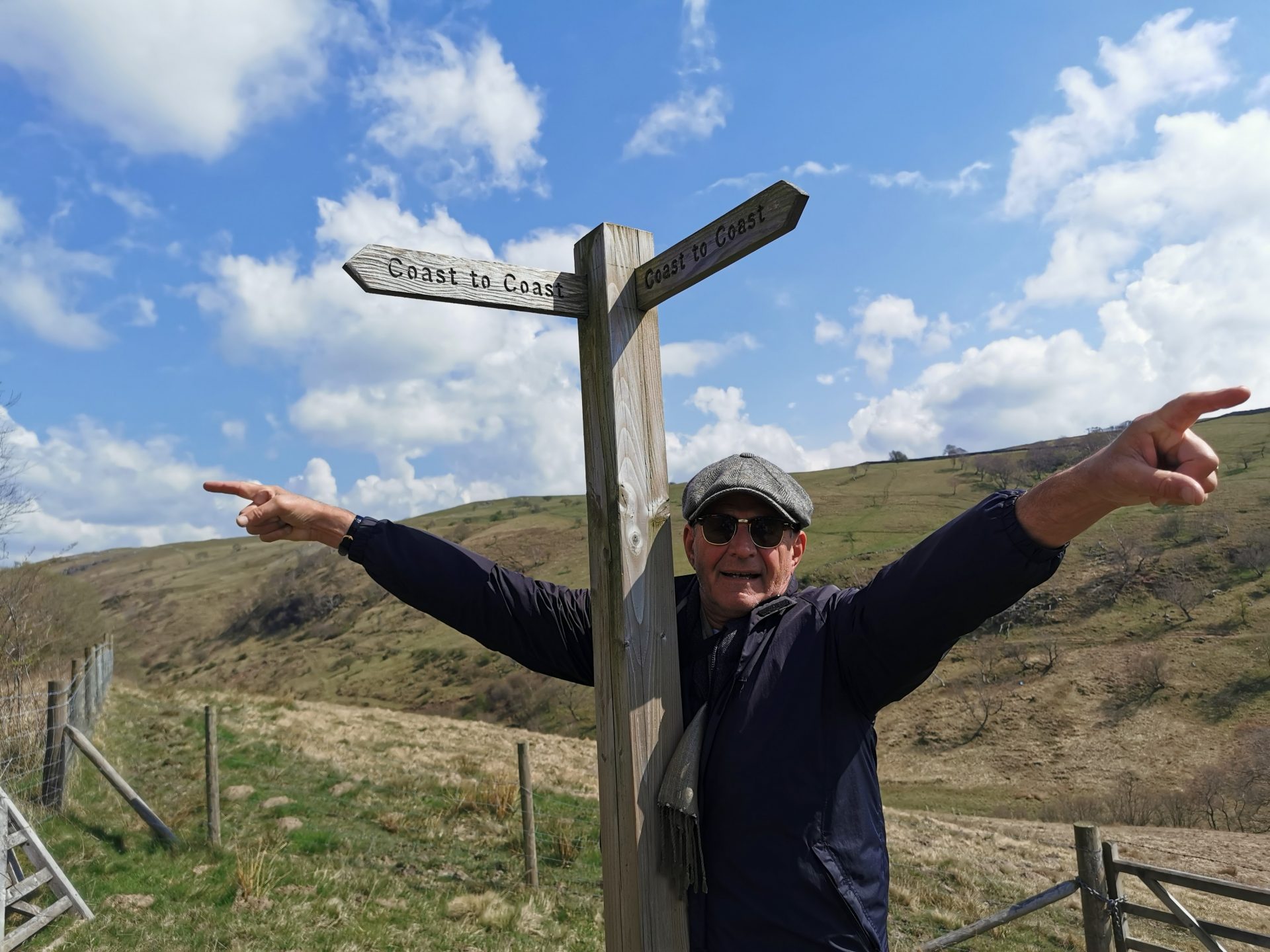
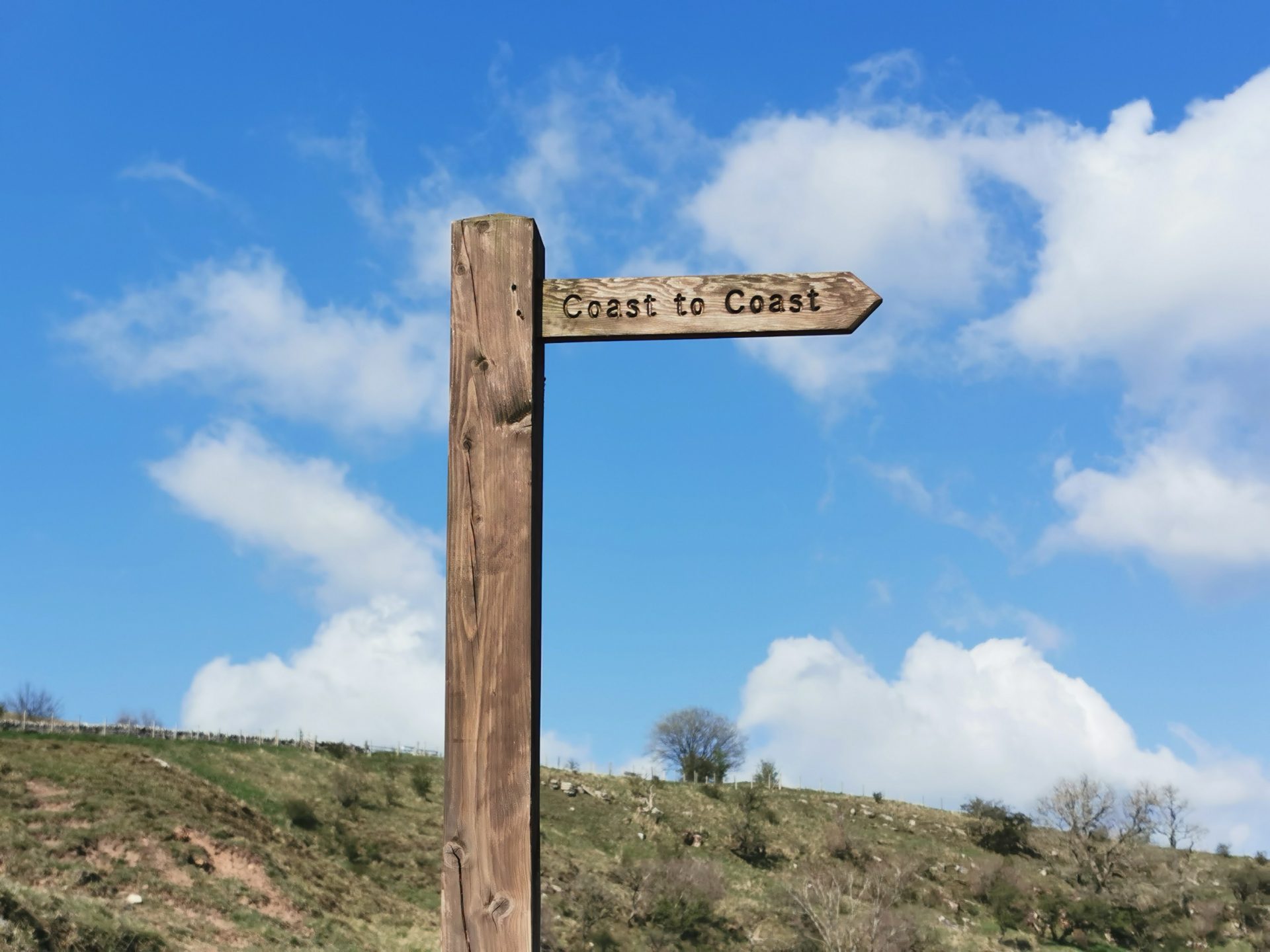
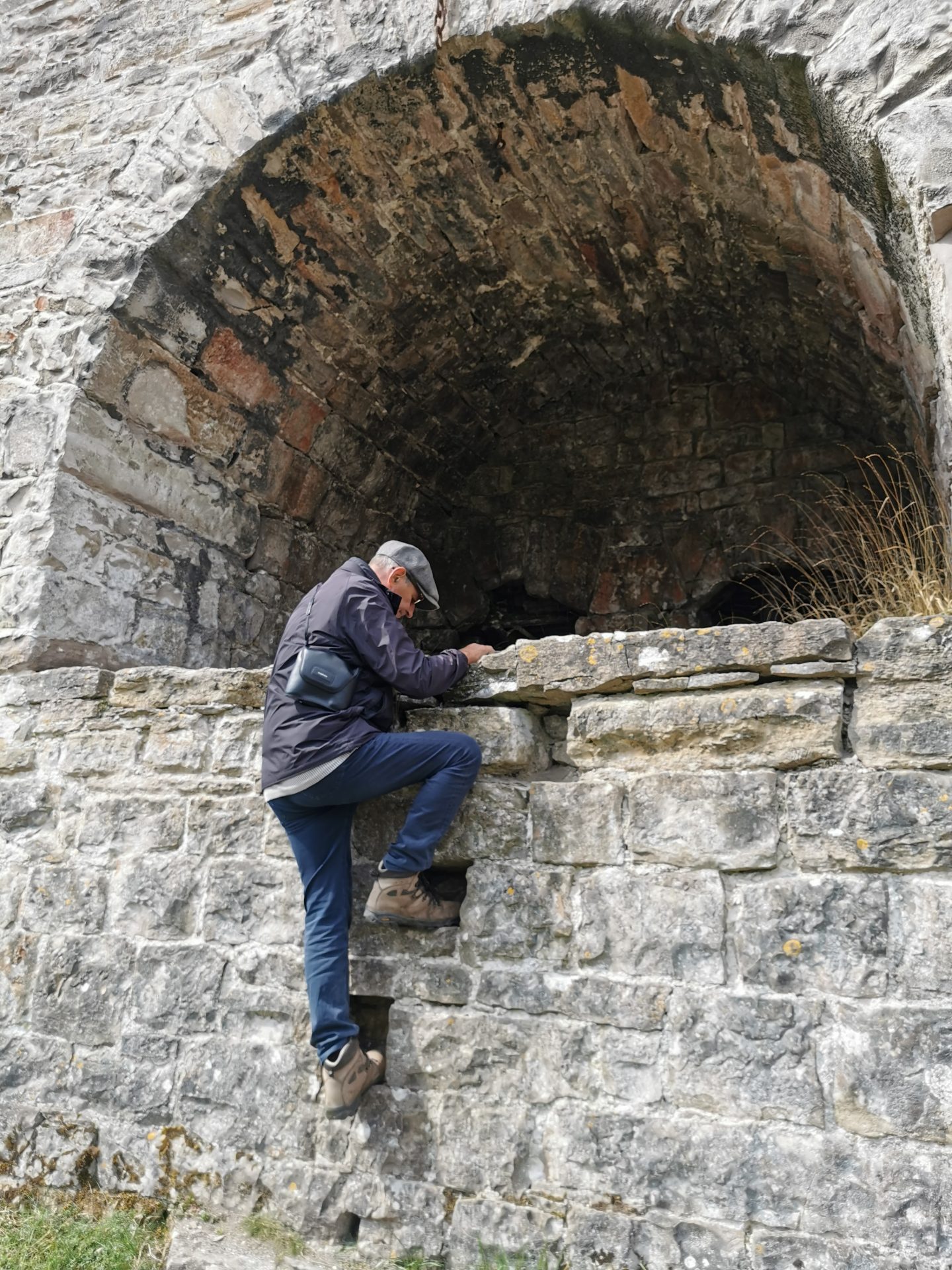
Taking the road from Ravenstonedale to Lower Swaledale from the village of Kaber reminds Jo of the South Downs, but we soon start the long ascent to the apparent wilderness of Stonedale and the Tan Hill Inn. At 1,732ft, the Inn is the highest in Britain; windswept, bleak, barren, surrounded by miles of high moorland. One of the loneliest places in the Dales, often wracked by high winds, as it is on the night we are there when the wind whips up to gusts of 40mph, sweeping the mist across the moor. We can hear it in the van howling outside, and feel it too as the van is buffeted about in the gusts.
Tan Hill Inn proves to be a pub of some character. Last winter, 61 people including an Oasis tribute band were snowed-in for three days by Storm Arwen. It must have been quite a party. There’s live music tonight with a 1970s cover band called “Also Known As”. The band’s very entertaining and hugely energetic lead singer hands out tambourines at the outset of the evening and creates a frenzy of singing and dancing. Jo eats a huge Yorkshire pudding in which nestles a rolled nine inch Cumberland sausage. I’m more conservative, eating a comparatively feeble looking chicken and ham pie.
The following morning, still windswept but clear, we awake in the van to the sounds of curlews, plovers and terns, and the sight of hardy bedraggled Swaledale sheep and their lambs – such survivors. On the drive down the hill we pass several groups of rugged hikers trudging up the hill – probably driven on by the prospect of Sunday lunch in front of one of the blazing wood burning stoves in the Tarn Hill Inn.
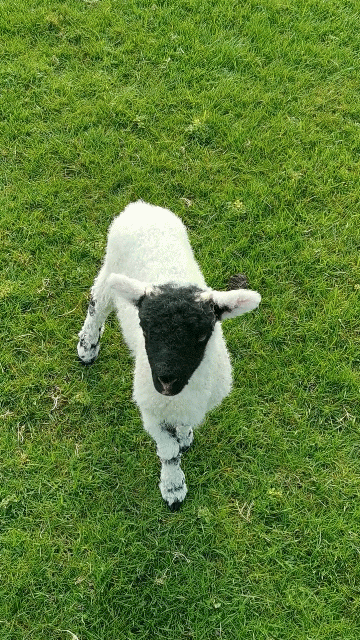

As we descend into Reeth on the Argarthendale road the landscape changes to lush green fields boxed in by dry stone walls, daffodils and remote grey stone farmhouses beneath the gritstone peaks of the hills – quite beautiful. Reeth is a lovely village with a big green surrounded by various drinking houses, licensed and unlicensed. We eat a light breakfast at the Copper Kettle café. Jo cannot resist the cake – eat cake forever that girl.
On to Richmond, just to the east of the National Park. It’s the world’s original Richmond. There are 65 others including Richmond Surrey and Richmond Virginia – they’re all descendants. We ride the Bromptons around town – hard work on the cobbles. We cycle a few miles to Easby Abbey by the river Swale where I spot a possible overnight parking site. Later we return to park up outside the sprawling ruins of the abbey where we spend a very quiet and comfortable night.
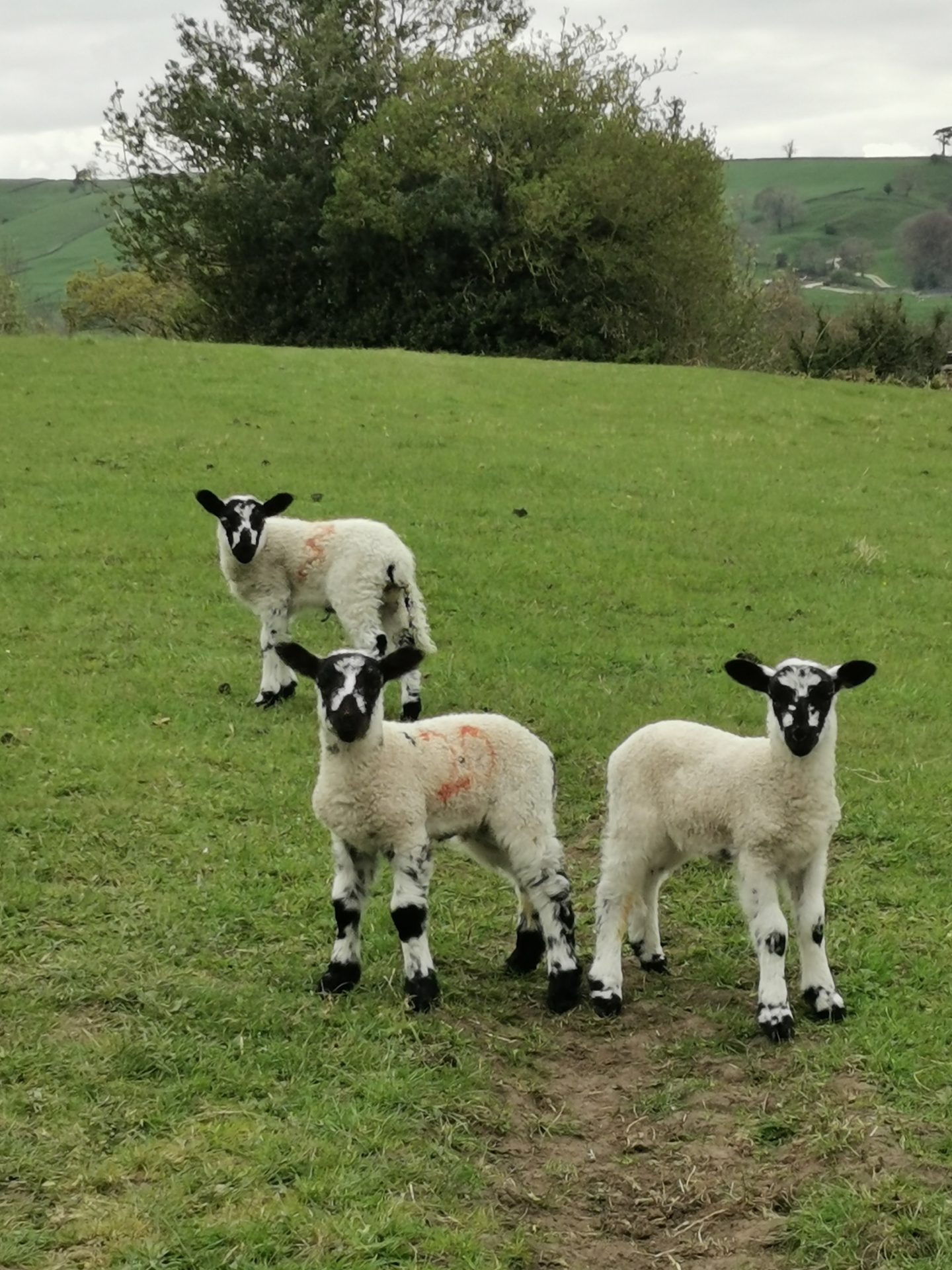
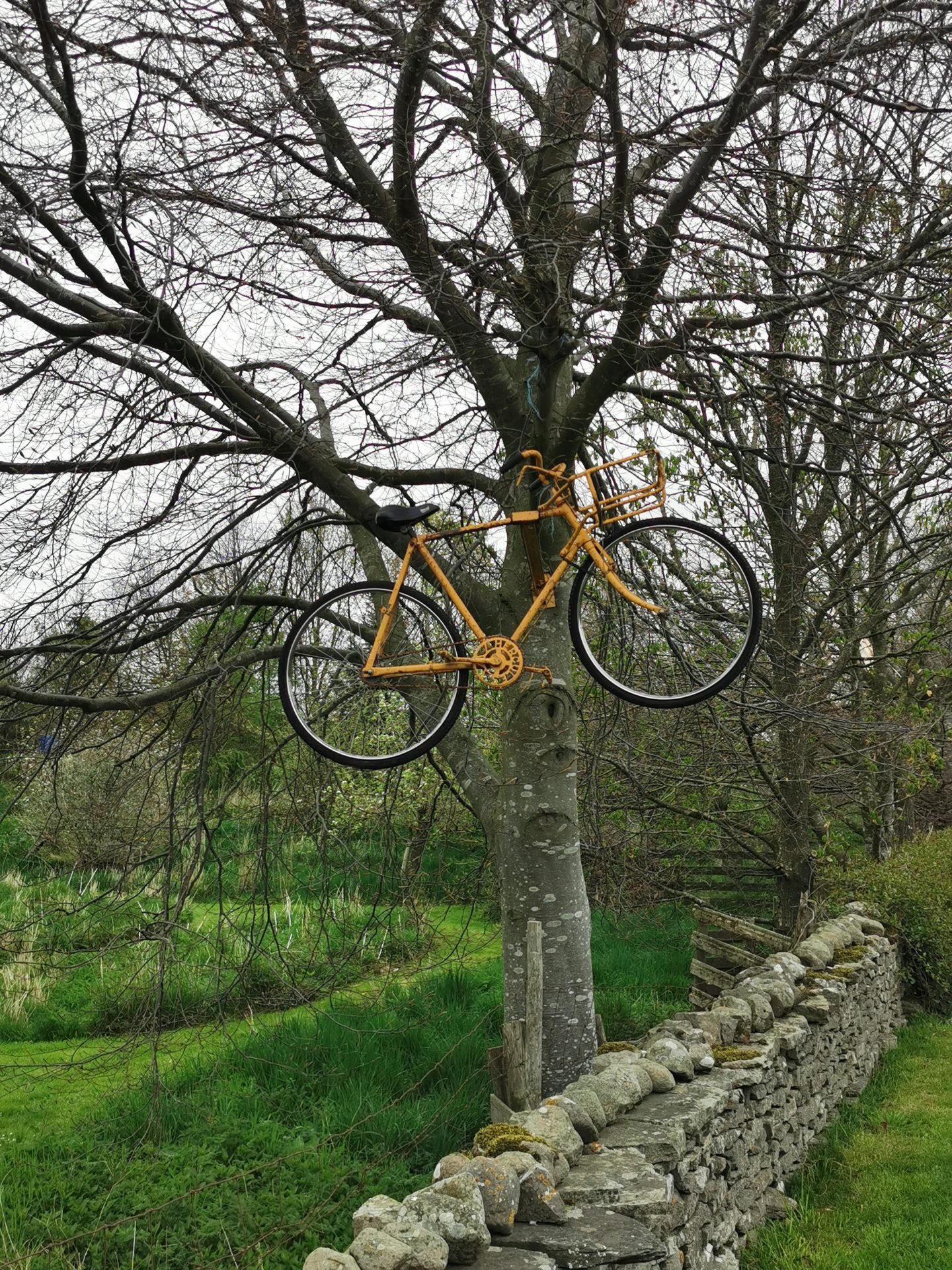
Easby Abbey dates from 1152 and its ruins were once painted by J M W Turner. He never actually painted it – he made a painting of it! In 1536 it was one of the first monastic houses to be dissolved by Henry VIII after which the buildings were stripped of their lead and partially demolished. The ruins are serenely magnificent. The following morning we shop in Richmond for clothes – something we rarely do. Jo buys new running shoes (in a charity shop – what luck! They have one pair and they’re the right model and size) and an assortment of all weather jackets. I buy sandals and new walking boots. We buy pork pies – well only I get a pie – Jo eats a pork tart topped with apple. Pie or tart, these pork creations are a delicious Yorkshire speciality.
The disused Victorian Richmond railway station is now a fine Arts Centre with a three screen cinema. We buy tickets to watch Operation Mincemeat, a World War 2 drama starring Colin Firth, Kelly Macdonald and Matthew Macfadyen – really excellent.
The car park next to Easby Abbey is so good that we stay there another night. The following morning is bright with a clear blue sky. Jo sets off to make the best use of the light for photographs of the ruins. We drive the short distance to Constable Burton where the renowned garden is, despite declarations online, closed. We shall return in May. Onwards to Wensley, of Wensleydale. It’s quite an insignificant village, possibly because it was ravaged by plague in 1563 and never really recovered. It’s remarkable, the legacy of such a distant event. We walk through the grounds of an unattractive stately pile called Bolton Hall and then back along the river Ure. Jo rates the walk, as she does all walks,but this on is only 5/10, mainly because it’s too close to a noisy road. These ratings cause much debate. Is it right to downgrade a walk because of the weather? Does a walk merit an upgrade because the pub is near the end? Yes definitely.
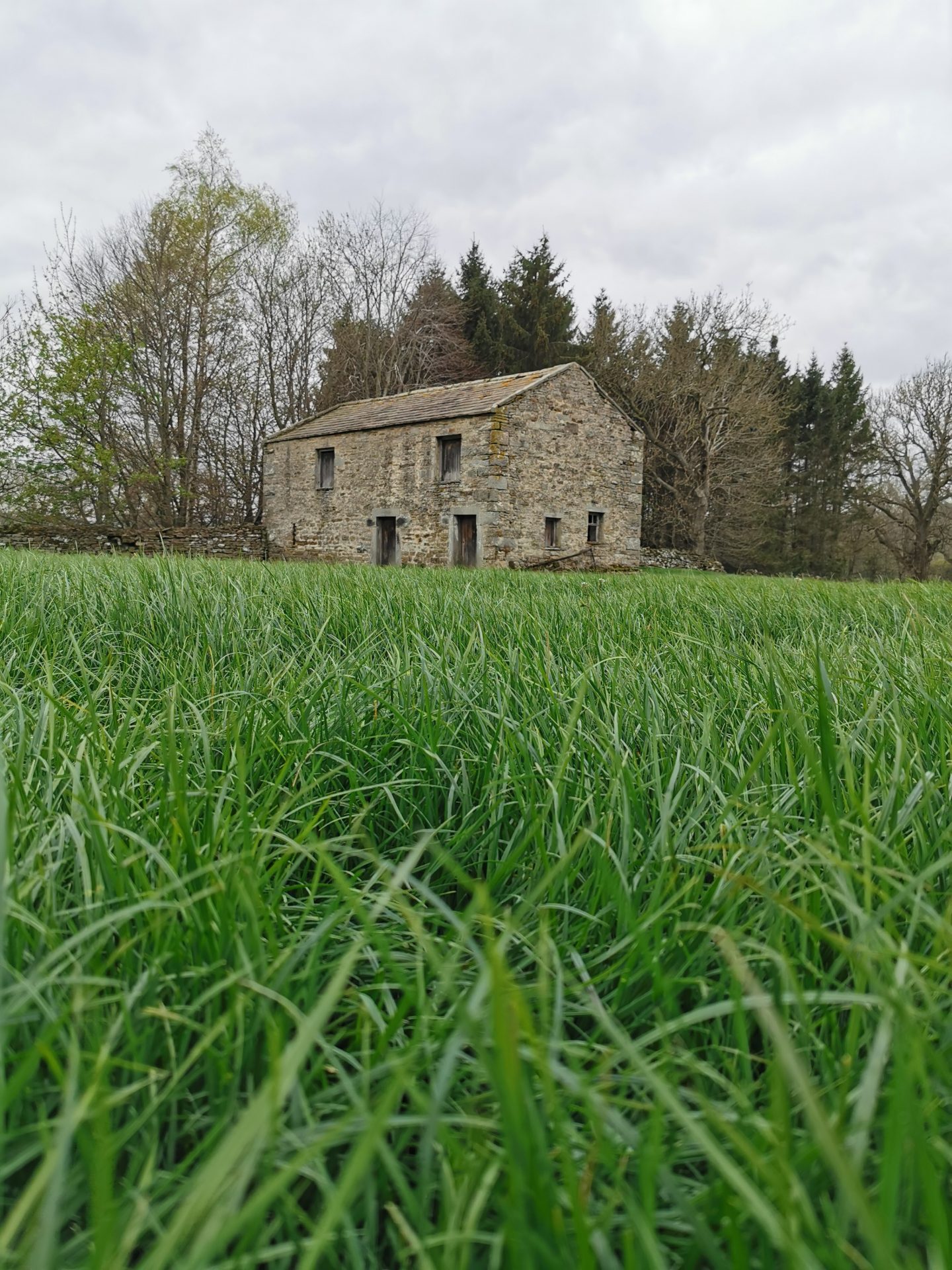
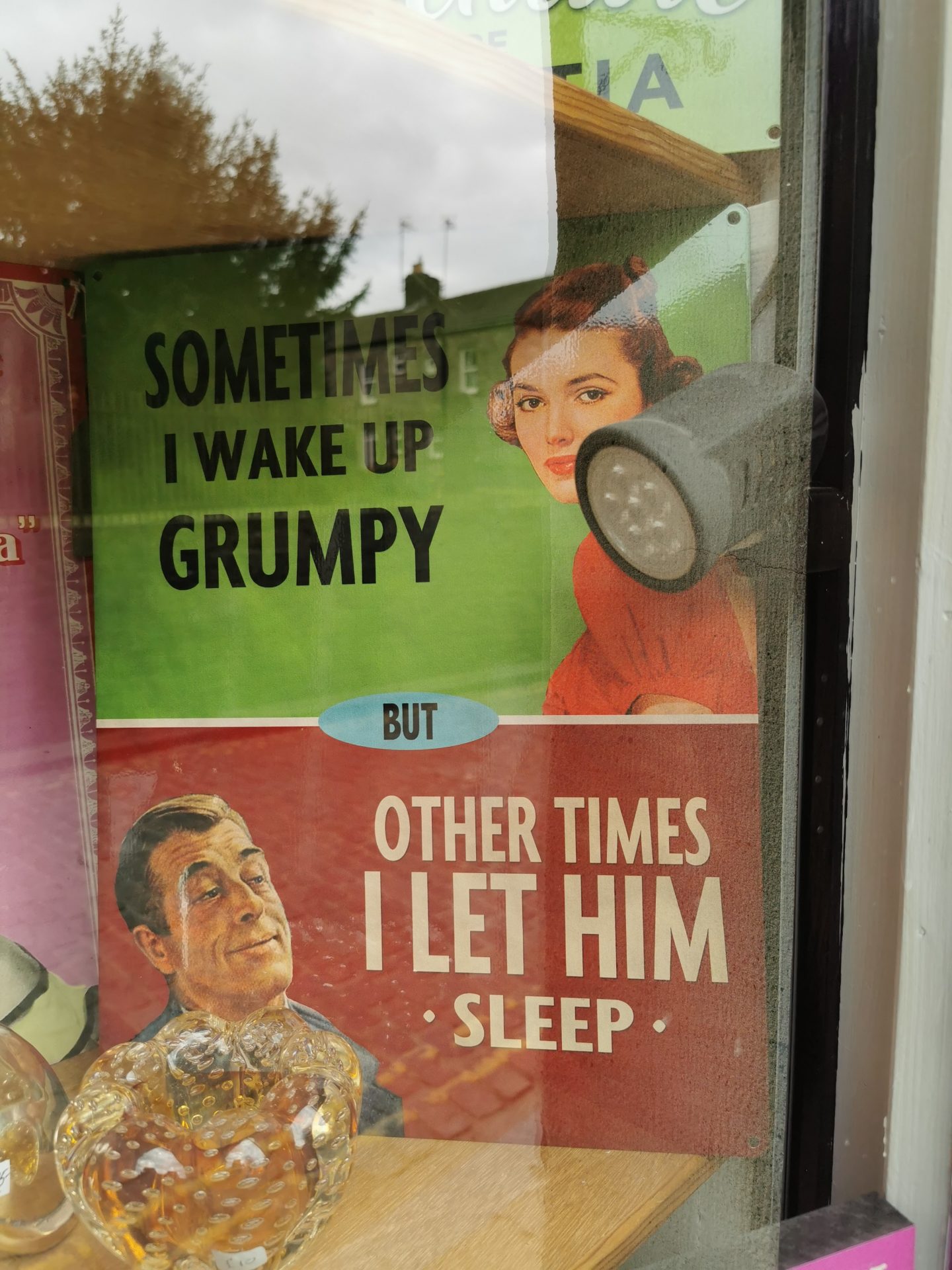
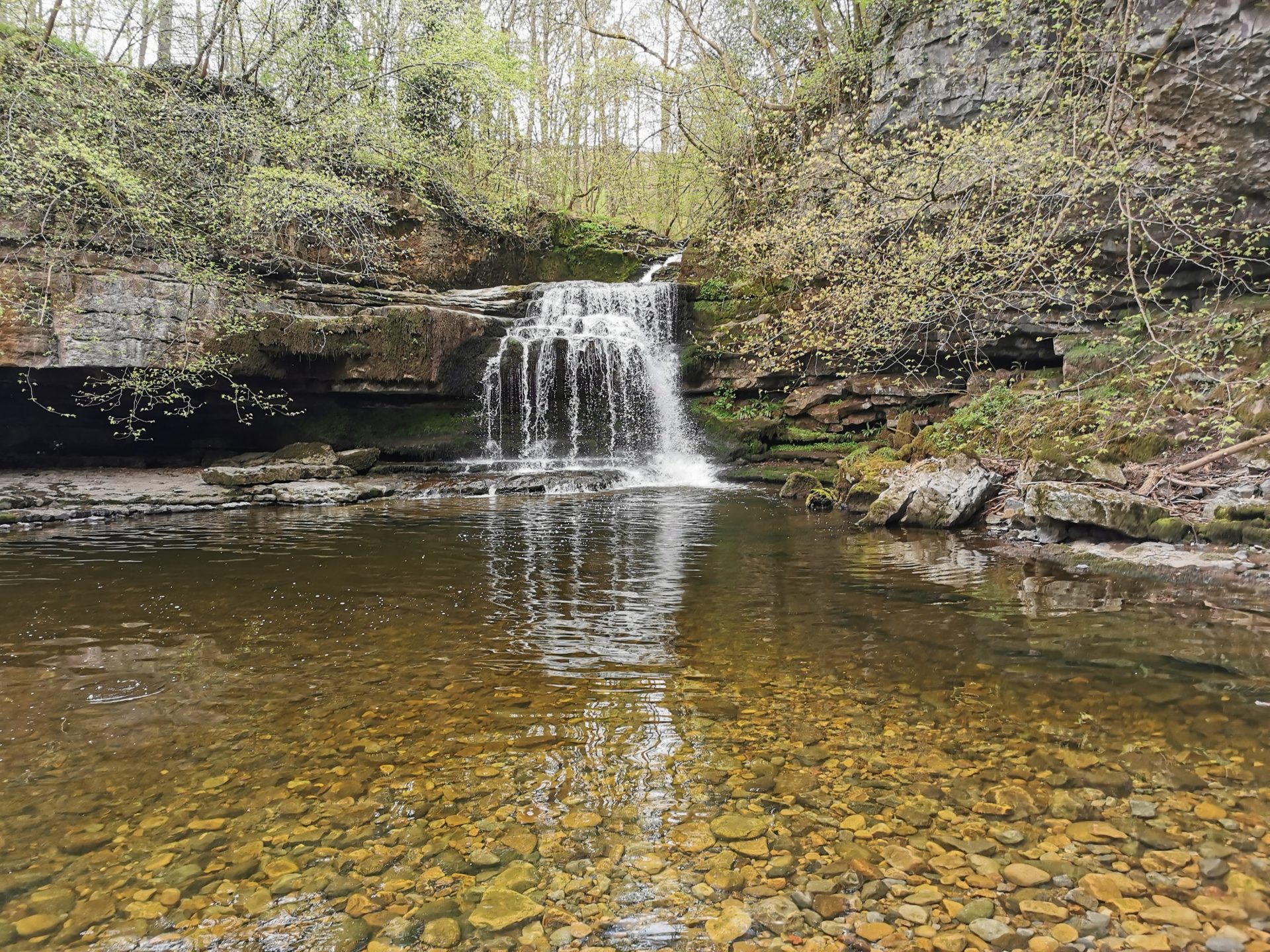
The following night we park up next to the racing horse gallops high up on Middleham Moor. I walk a short way into the moor to discover that the Settle to Carlisle railway is in a tunnel immediately beneath us. It’s very cold so we stay in the van, drink red wine, and eat egg mayonnaise and tuna fish mayo sandwiches.
It’s bloody cold overnight. We’re wearing socks and thermal underwear under a double duvet and a blanket, inside of which is a hot water bottle. Jo’s even wearing a fleece – it’s like sleeping with an Inuit. We enjoy the occasional cup of tea which has the added benefit of the hot kettle warming up the van. My reliable bladder insists upon an outing in the early hours but I lie there in the hard won accumulated warmth, putting off the inevitable cold and possible frostbite. But once outside the van, it’s very still and the stars are out of this world.
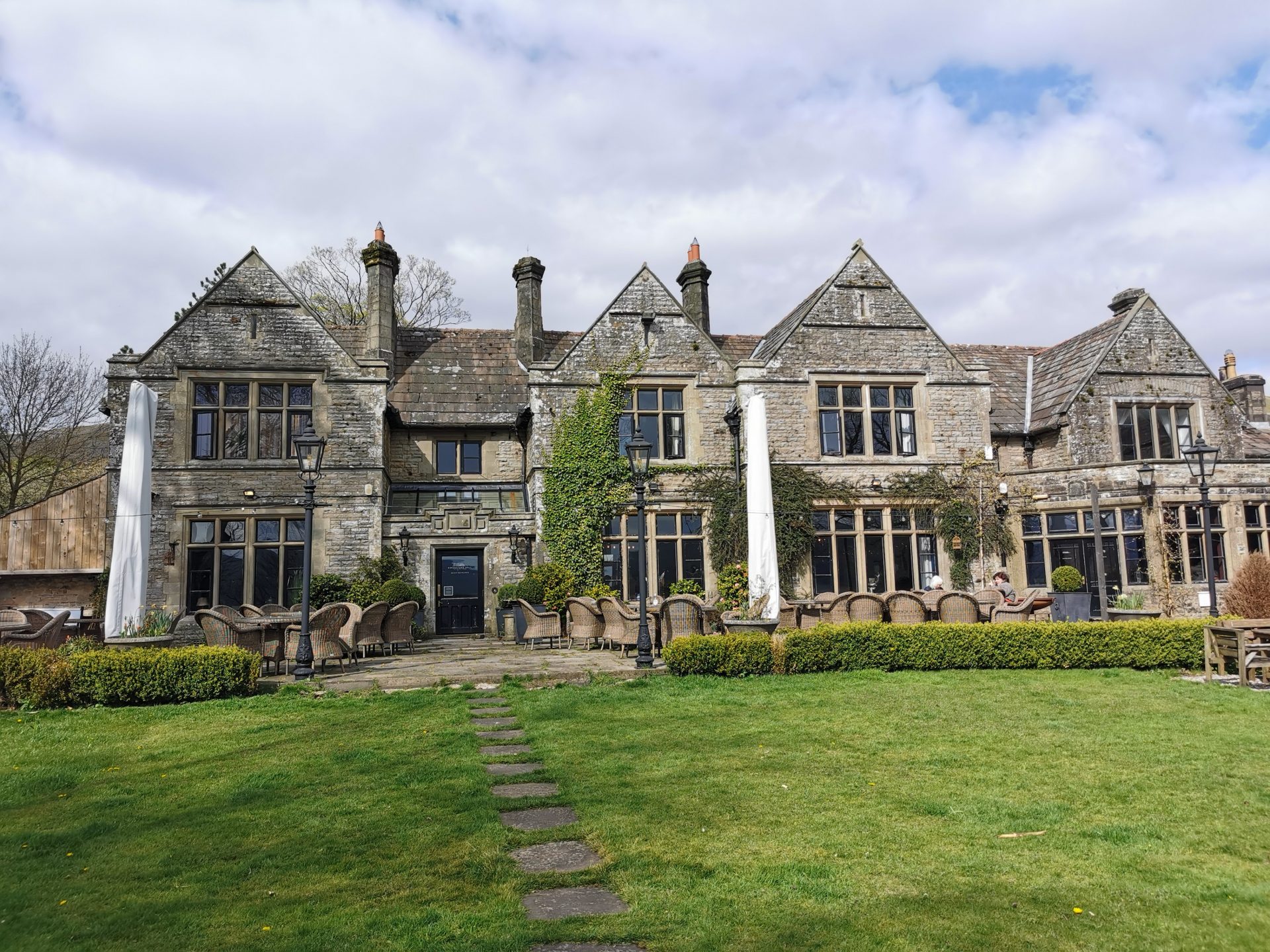
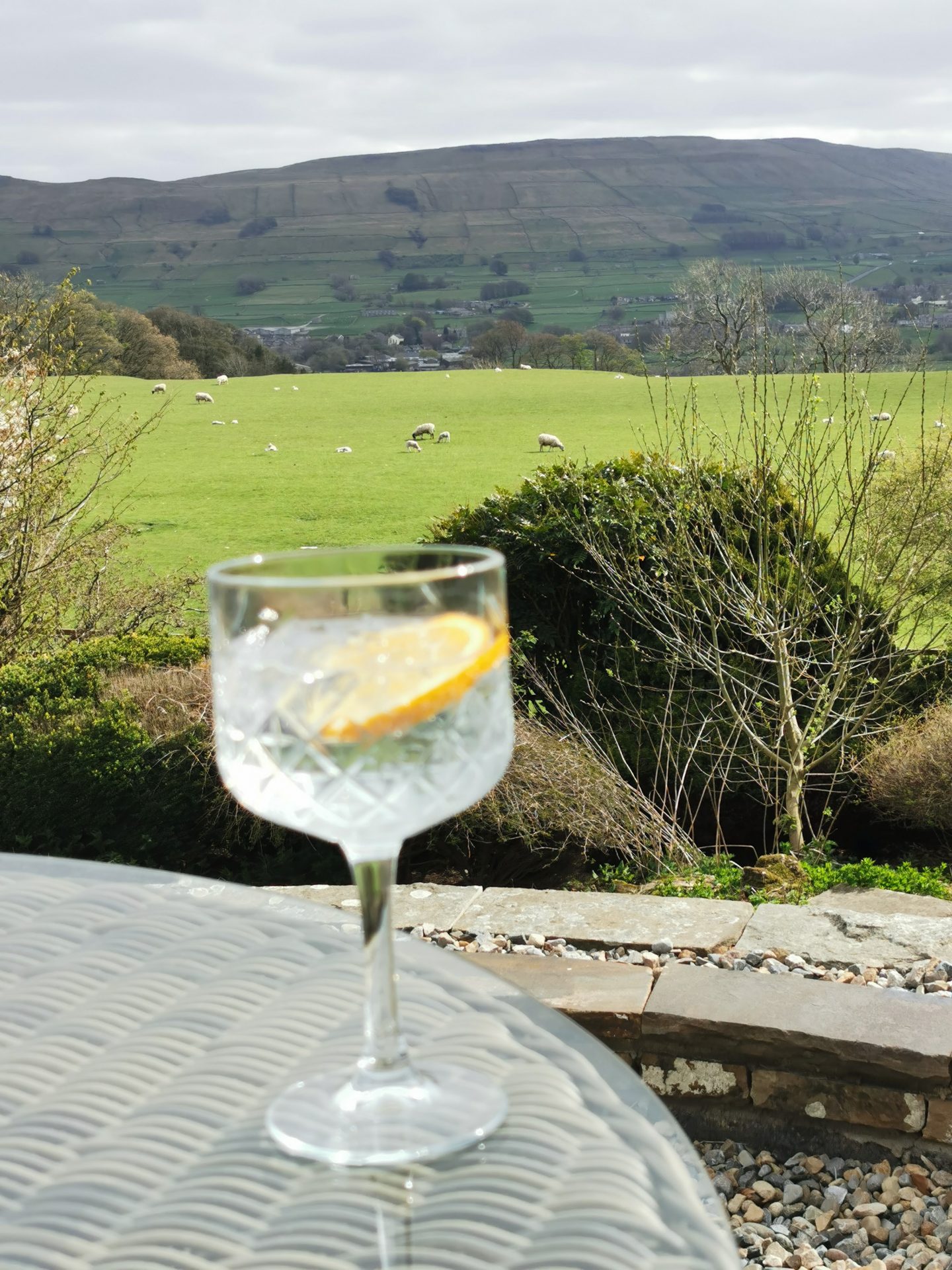
The next morning we awaken to the sight and sound of beautiful race horses being exercised along the gallops. Friendly riders too. Over tea we decide that we must find accommodation for tonight. The forecast is for more freezing temperatures and we feel that we need and deserve some warmth and comfort. Jo has spotted an hotel on booking.com that she has wanted to visit for a drink on their splendid terrace overlooking the hills of Wensleydale. Simonstone Hall is a two-story 17th Century stone-built house with gables, mullioned windows and stone slated roofs. It is built on elevated ground overlooking the river Ure, the market town of Hawes and the verdant fields and hills of Wensleydale. It keeps a fine wine cellar and a muster of peacocks. Sounds inviting? It’s over our budget at £105 including breakfast but it’s good value given Hawes youth hostel wants £67 for a room with no breakfast.
We book a room for the night and then, with some amusement, I belatedly read the TripAdvisor reviews. The place seems to be, whilst not exactly run down, a little tired and dusty. The reviews suggest that service can be inconsistent. What makes me laugh is that the General Manager, Jake, has a blistering Basil Fawlty type response to any critical review. If you don’t like it, you can get stuffed and check into the Premier Inn down the road. But it’s a hotel of great charm and character in a magnificent location, and the staff are delightful. It’s very comfortable, but not perfect, which I find to be one of its many charms. And amusingly, it’s the hotel where the TV broadcaster Jeremy Clarkson, during a late night argument over food, physically and verbally abused his producer, leading to him losing his job with the BBC and the defection of Top Gear to Amazon.
We book for one night but stay for two. The clean sheets, towels, robes, the pervasive warmth and hot baths are joys I cannot exaggerate. Sitting in big old worn leather armchairs in the Drawing Room, we drink Chilean Carmenere red wine. There’s a muster of five peacocks, at the bedroom window, to awaken us in the morning. It’s wonderful.

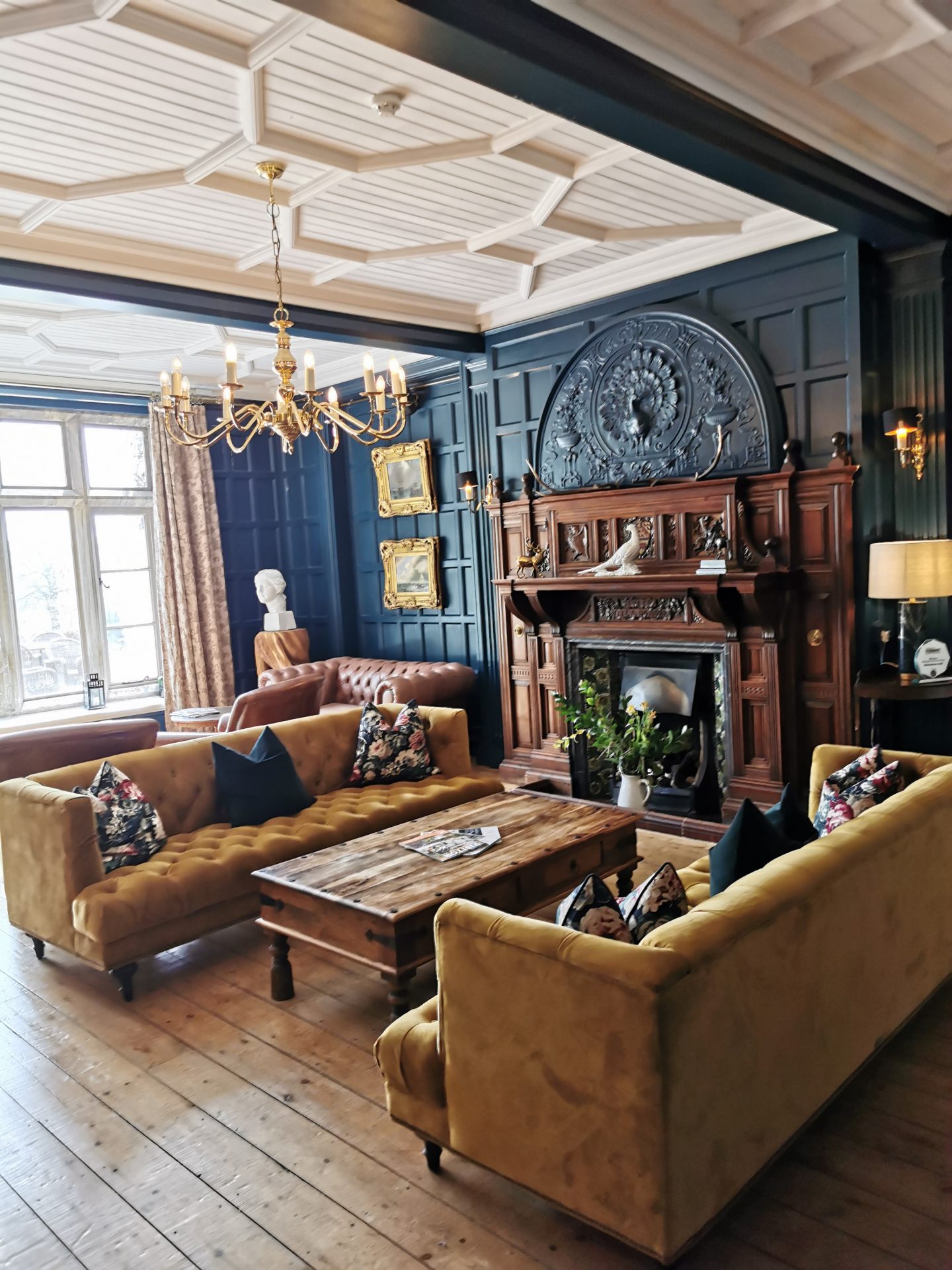
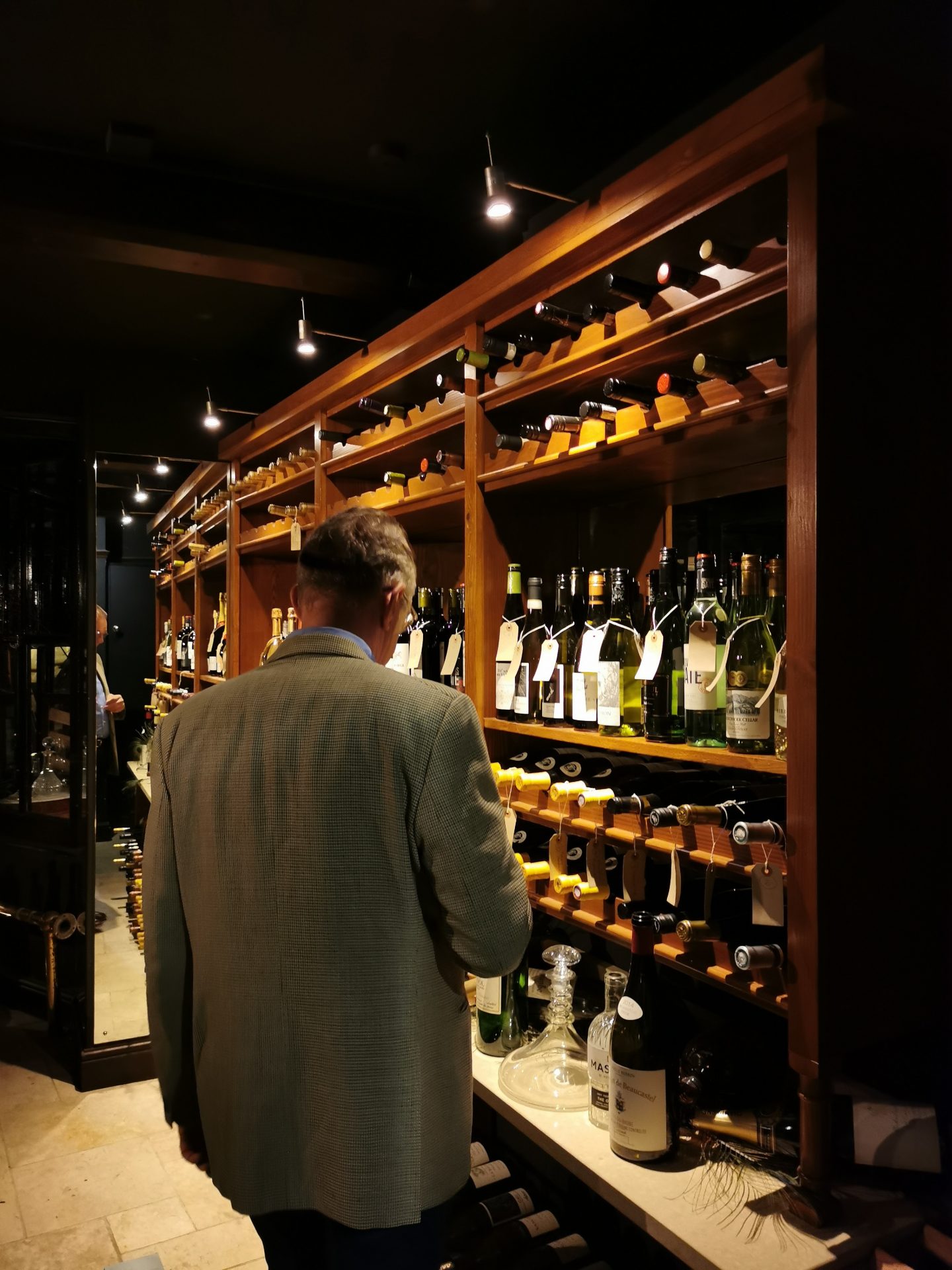
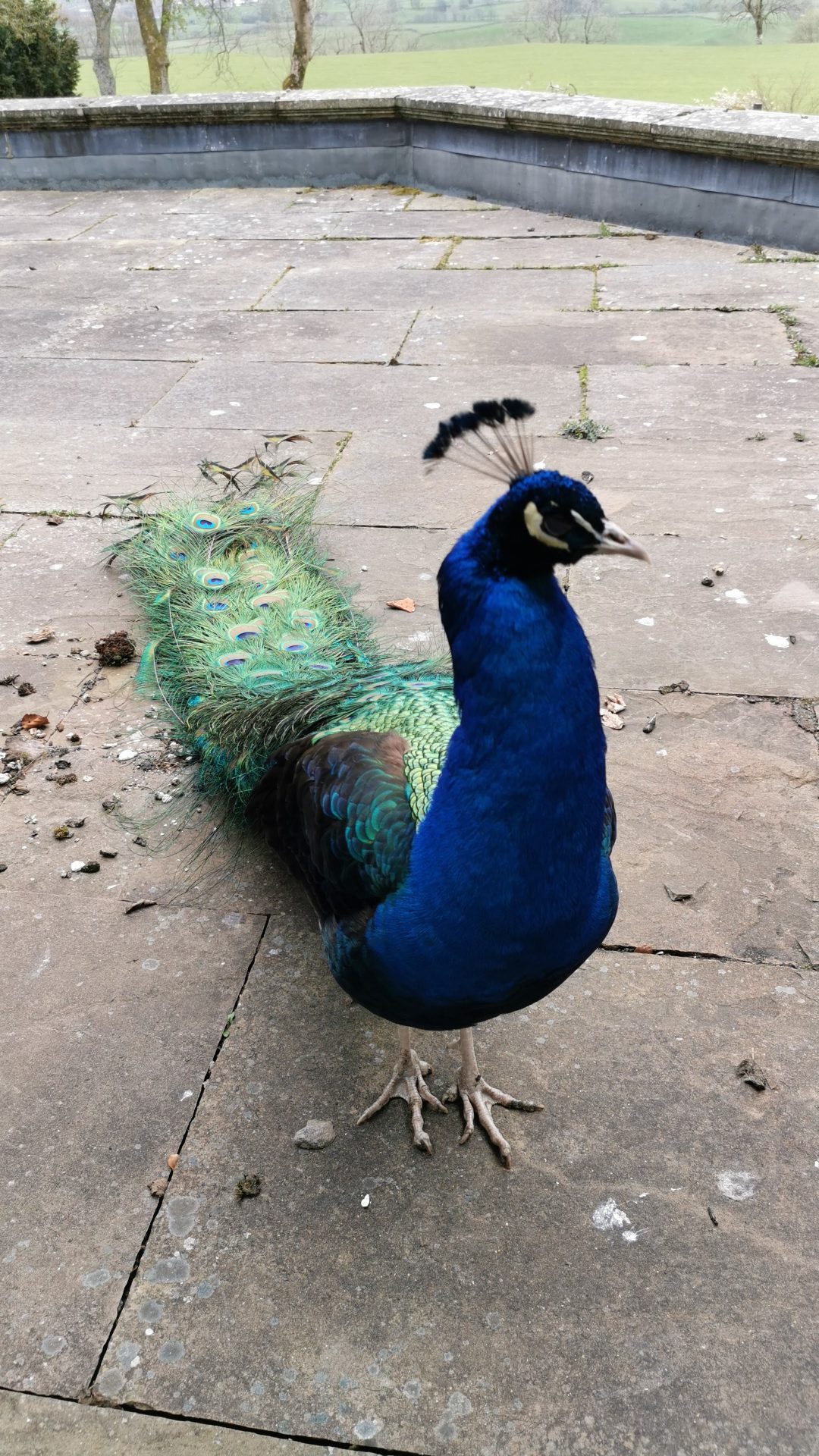
We walk a splendid, varied and beautiful eight mile route along part of the Pennine Way from Simonstone Hall to High Clint on the windy barren Stags Fell where we see loads of birds – we always do when I leave my binoculars behind. Jo wants to visit yet another waterfall so I find a comfortable seat with a pint of Theakston bitter by the coal fire in the low ceilinged, oak beamed George and Dragon pub. Jo pays an exorbitant £4 (almost the price of my pint!) to see the highest single drop waterfall in England, Hardraw falls. It pours over a 100ft limestone cliff, although the lip was rebuilt after a flood so it’s actually man-made.
Let’s be honest about waterfalls. They exist in interesting stretches of river amongst hills, craggs and ravines which I like very much. But the falling of the water itself leaves me underwhelmed. I think they’re overhyped, overrated tourist traps. If you can’t swim in the pools they create then why bother. It’s like getting excited about a running tap or the emptying of a bucket of water. A much better idea is to head to the nearest pub and watch the ale flow.
In the evening we walk the short distance down the hill from Simonstone Hall, back to the George and Dragon for dinner. Pies come recommended; steak & ale, and chicken, ham & leek with mash, peas and gravy. Simple fare. Brilliant.
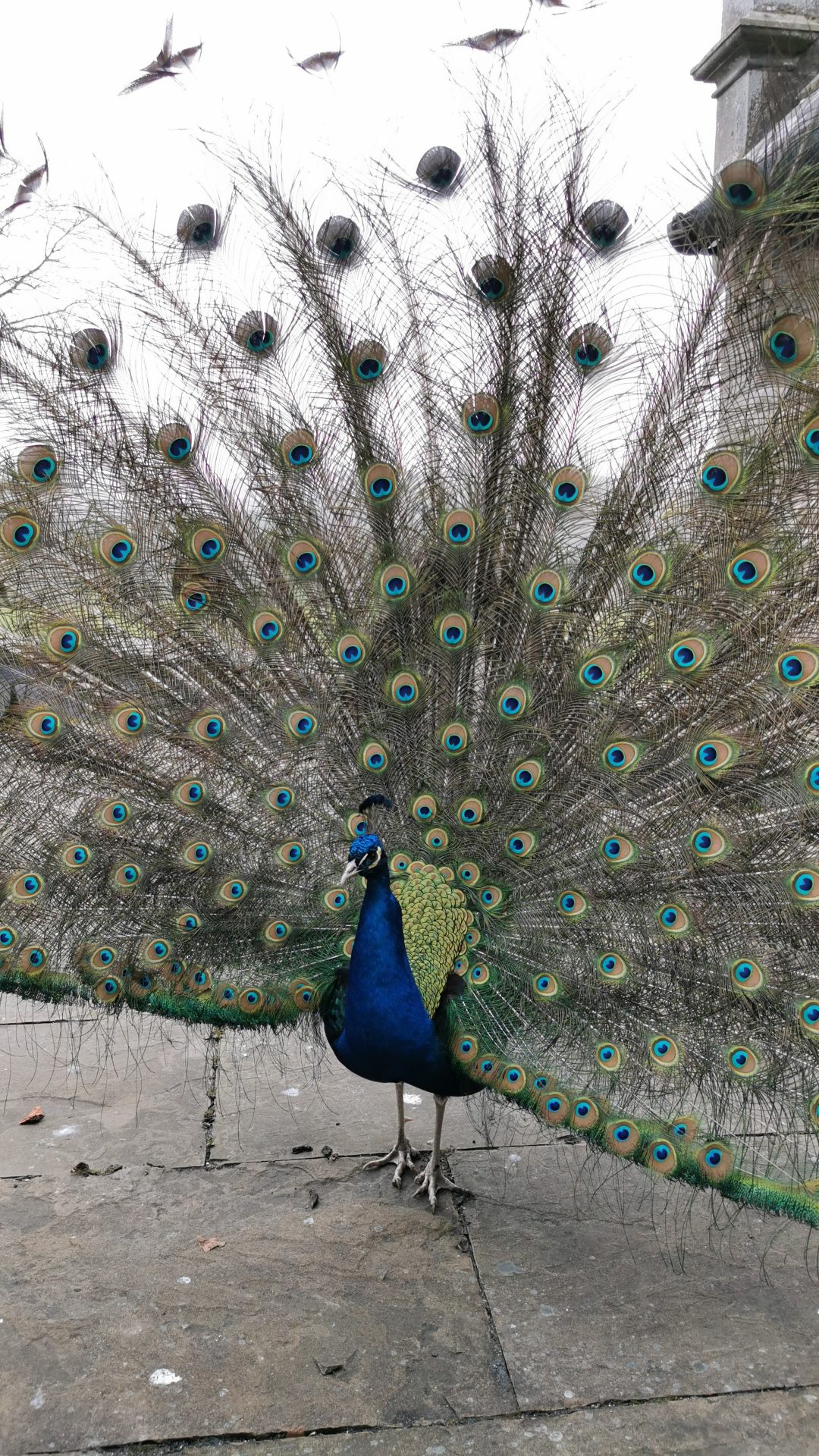
The smart village of Middleham has a castle, a grand looking manor and a number of prosperous looking townhouses. We head off on a six mile walk to Aysgarth Waterfalls from lovely West Burton in Bishops Dale. Wensleydale, unlike its neighbour to the north, Swaledale, is characterised by verdant green hills dotted with many large stone hay barns. We should return, later in the year, just before the hay harvest. The ubiquitous sheep of the Dales are replaced by dairy cows. This is milk country, cheese country; Wensleydale cheese.
Aysgarth falls must be quite something after heavy rain. It’s very wide with many cascades. Jo just finishes a short video of it when a low flying F16 fighter jet roars over our heads. Our walk ends at the swimming waterfall, Cauldron falls in West Burton, yet another pretty village with a beautifully manicured village green.
The sun is out as we drive through the Buttertubs Pass, one of the many high roads and passes in the Yorkshire Dales with fantastic views of the surrounding valleys and fells. This road crosses the high moorland between Wensleydale and Swaledale. We pull in at the summit and visit the limestone potholes which give the pass its name. The story goes that as farmers rested at the top of the climb on a hot day – on route to the market in Hawes – they would lower the butter they had produced for sale into the potholes to keep it cool.
At the lovely village of Askrigg Jo maps out a short circular walk to Mill Gill Force (Force is an old viking word for waterfall). ‘It’s as nice as Hardraw falls’ says Jo. I couldn’t say as I preferred a pint of ale to Hardraw waterfall. Then a quick visit to check out Gayle Mill, dating from about 1784, it’s thought to be the oldest structurally unaltered cotton mill in existence in England.
In Askrigg, the cobbled market place has an iron bull-ring, where bulls were ‘baited’ (set upon by dogs) in the 17th and 18th centuries. According to local tradition if a man wanted a fight he would flip the bull-ring over. If another wanted to take on the challenge he turned it back, and the fighting began. Jo loves this type of folklore and wants to photograph the ring. But as in all pretty Dale’s market squares, the attractiveness of the space is spoiled by parked cars, one of which is parked on top of the bull-ring. Jo insists we find the damned thing so I’m peering under cars looking for it. I find it and make a note to get some reward later.
We drive down the steep 25% gradient to the northern shore of Lake Semerwater. Unlike its neighbour Cumbria, there are few lakes in North Yorkshire. There are plenty of manmade reservoirs but only two natural lakes. Semerwater, only half a mile long, is a 10,000 year old glacial lake. Geologically relatively young, its shores are populated by flocks of resident and migratory waterfowl including assorted ducks, geese, terns, oysters catchers, plovers and curlews. A cacophonous gathering, even at night.
The Pennine hills to the west, shelter Yorkshire from the worst of the wet westerly weather and the county is reputedly the driest place in England in April. We arrive on a still, cloudless afternoon and park up on the stony beach (charge £9, payable to the local farmer). Jo has plans to walk for a few hours but the scene is too lovely. We relax in the sun till it sets beyond the western shore.
The following morning is beautiful – the still lake presenting a perfect reflection of the surrounding hills. We watch as a fellow campervanner goes for an early morning dip; an impressive feat without a wetsuit in water temperature of 9 degrees. I’m tempted to give it a go but a week ago I injured my elbow and need to keep the wound clean (an excuse that I’m sticking to). I’ll come back later in the spring for a ‘warmer’ swim.
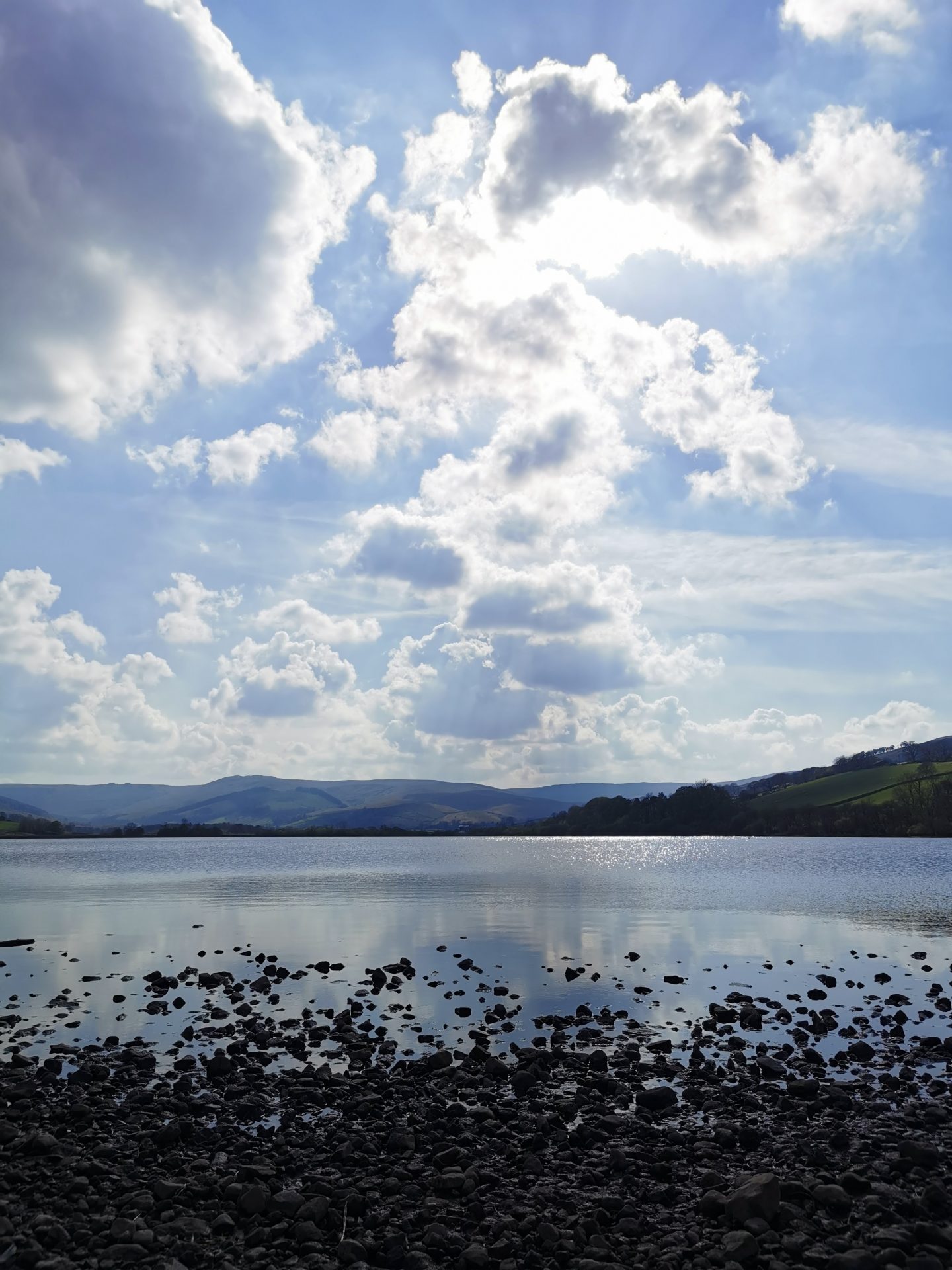
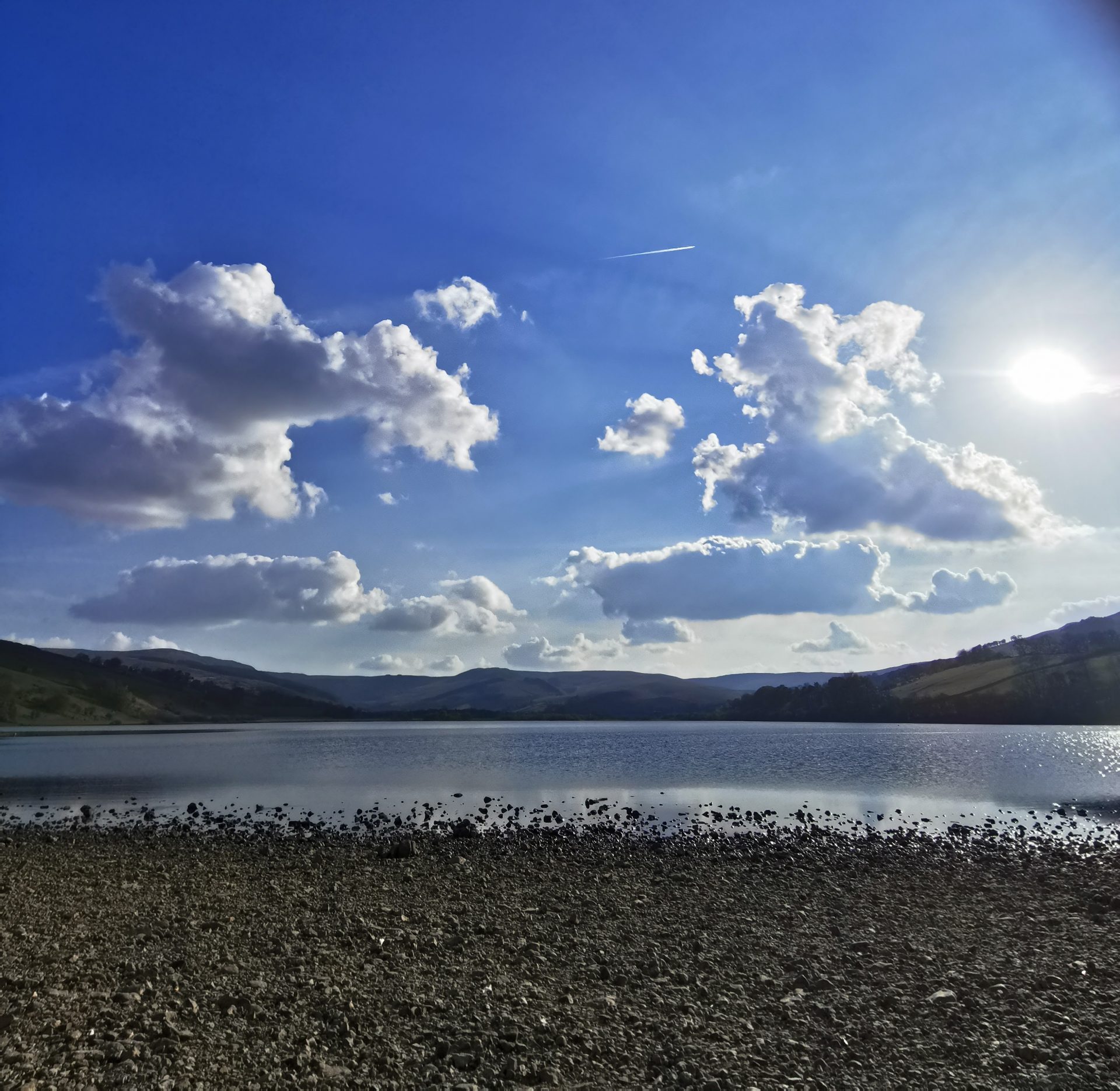
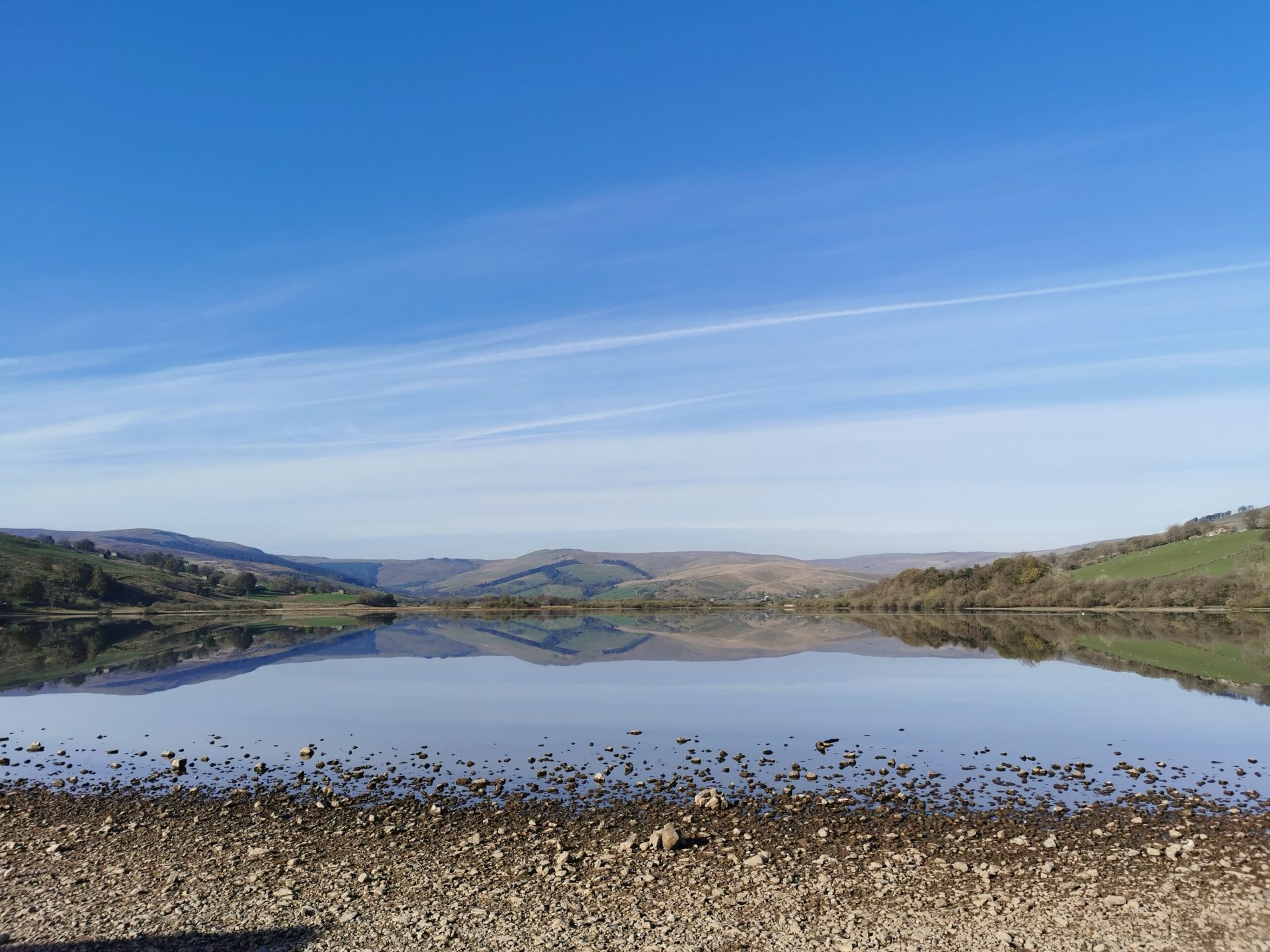
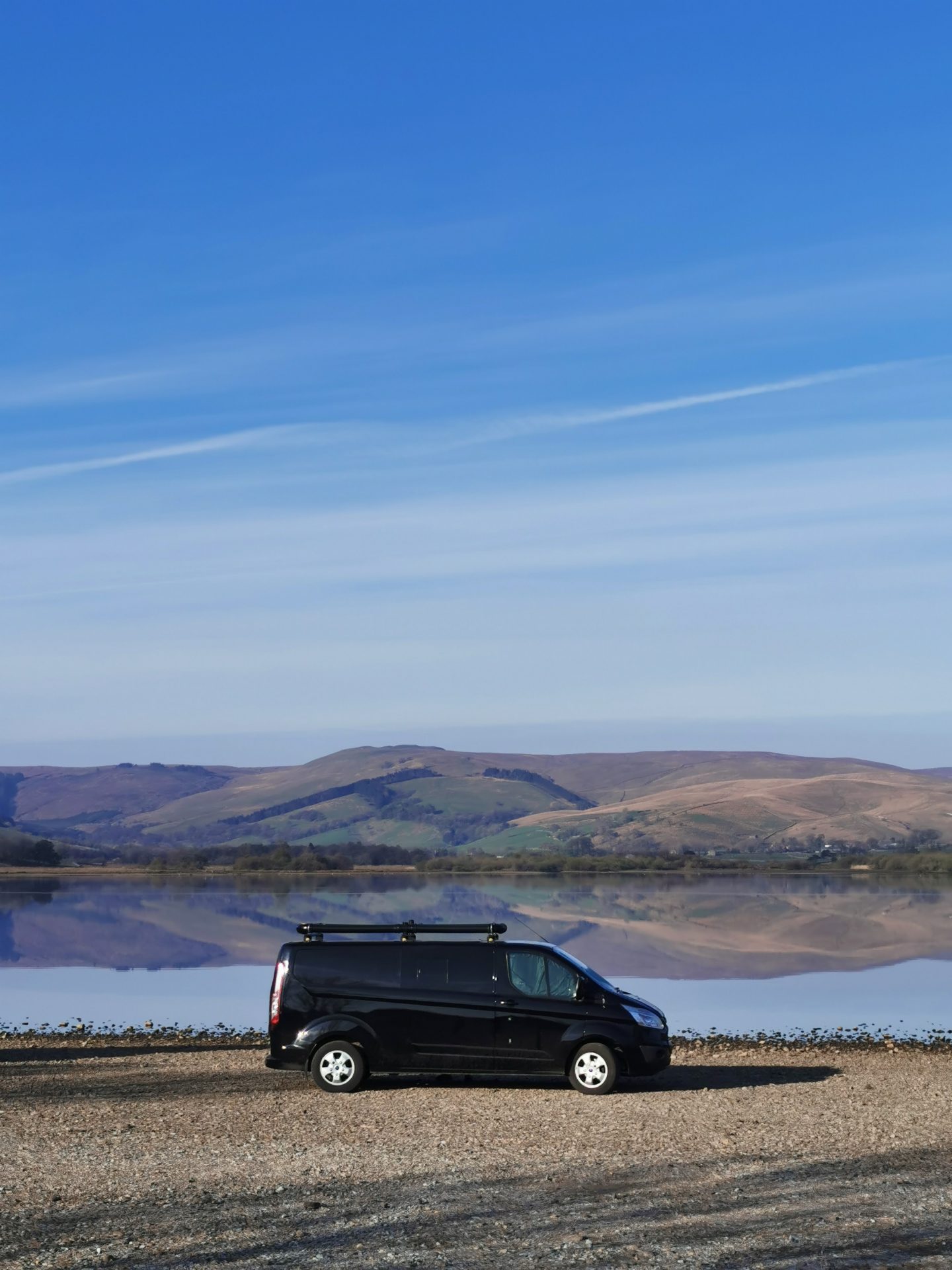
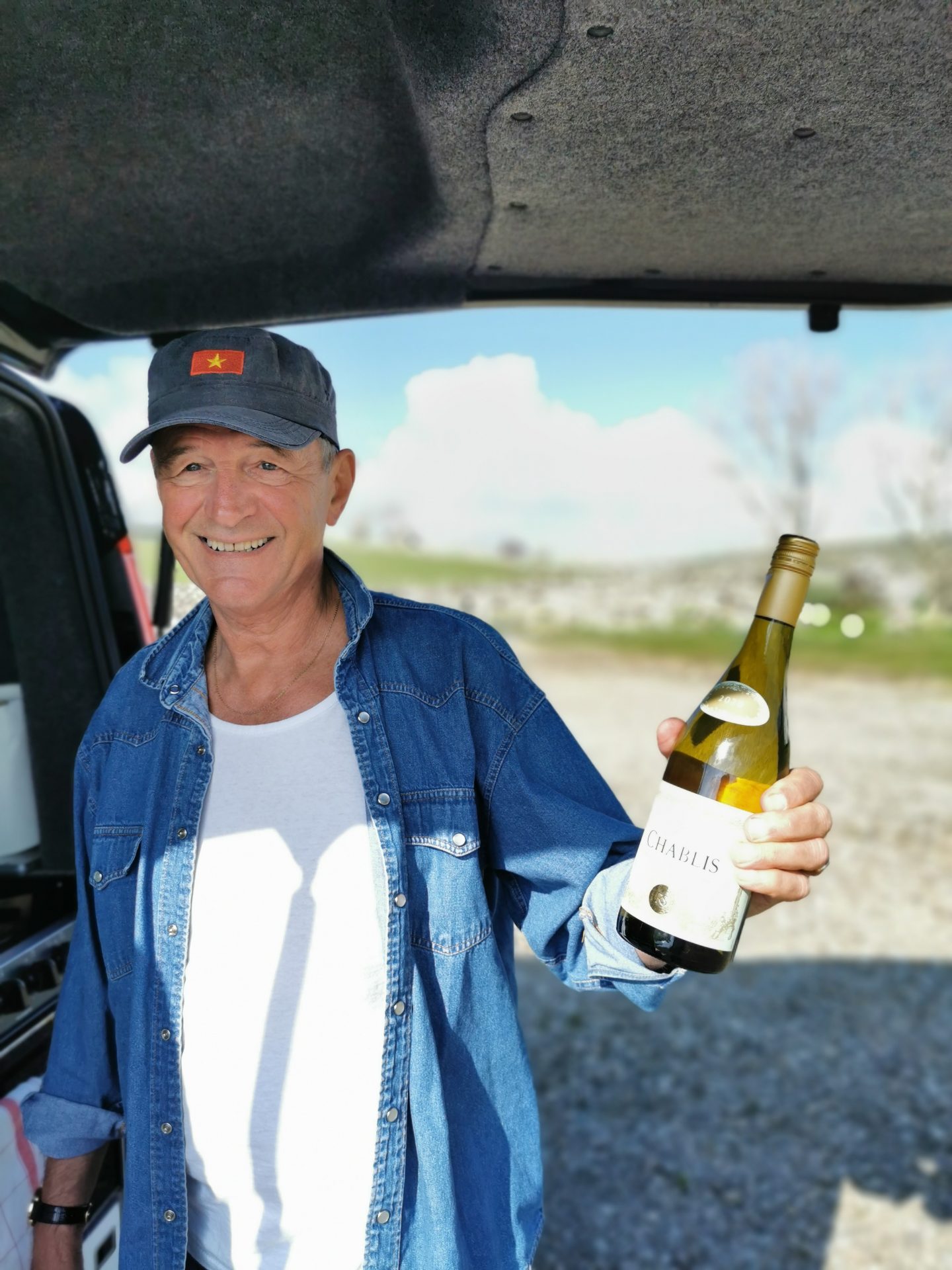
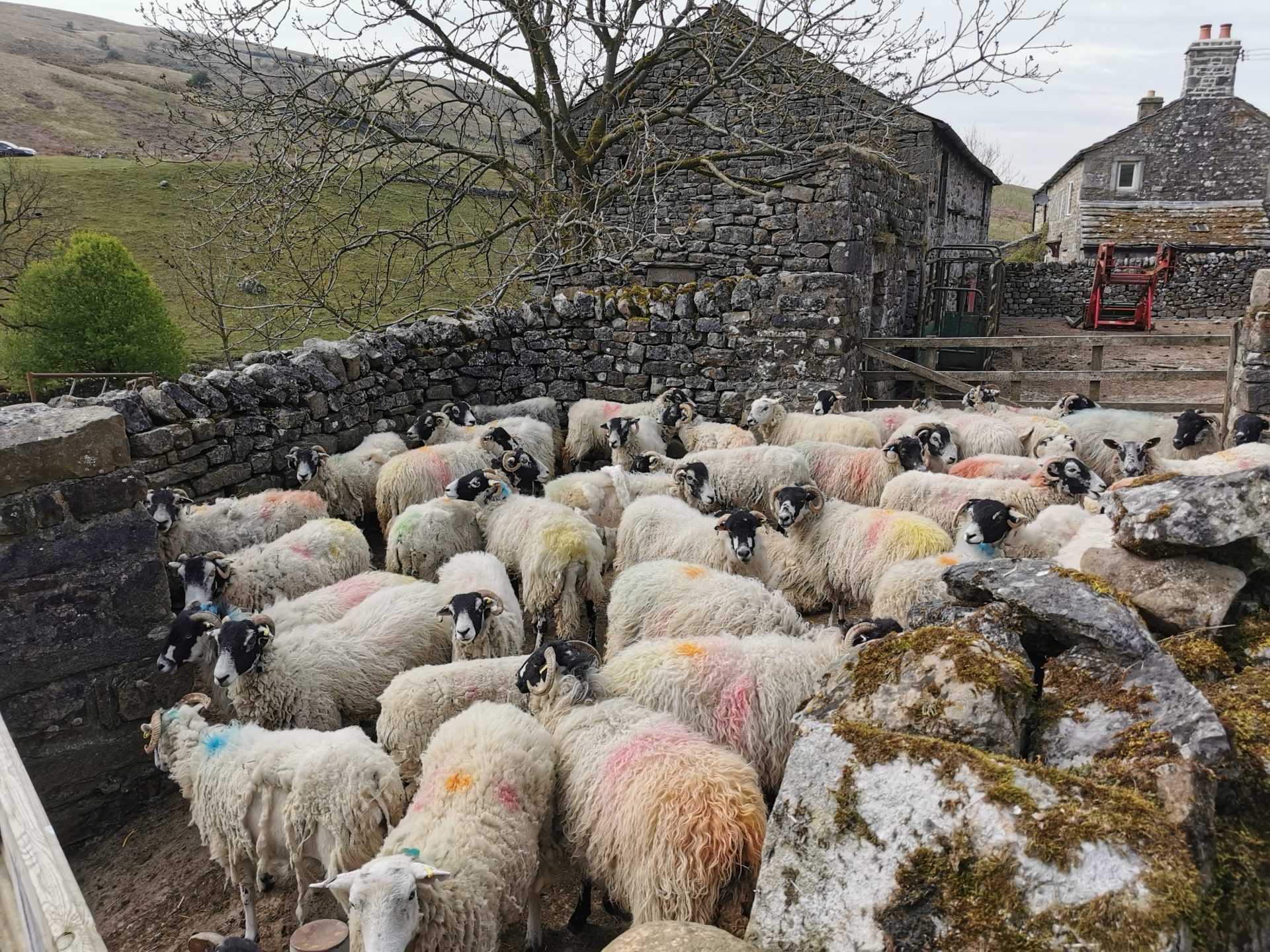
It’s the last day of April and we drive the A284 towards the pretty village of Bainbridge (there are so many pretty village in the Dales.) This A road looks great for cycling – it’s relatively quiet even on this holiday weekend, and there aren’t too many killer ascents. We drive to West Witton and take a tiny sharp turn to Carlton. This long narrow lane descends through the beauty of Coverdale to Kettlewel in upper Wharfedale. It’s rated as one of the top ten best drives in the Yorkshire Dales. The road descends through a stunning limestone valley with a few hairpin bends and dips and curves, with great views down the valley. It’s quite stunning.
Kettlewell is too busy for us. We drive on to the hamlet of Cray where, just beyond the village we park up on a flat piece of ground on the summit of a hill from which we do a nine mile circular walk along a high ridge and then down, back along the river Wharfe. We walk through Buckden village and visit the attractive Norman church of Hubberholme village. J B Priestley, one of Yorkshire’s best-loved writers and an early travel writer (I loved his 1933 book English Journey), requested that his ashes be scattered in the churchyard. Priestley is also said to have described the nearby 18th-century George Inn as his favourite watering hole – unfortunately we miss it.
We need to be back in Nidderdale where we spend a couple of nights (£10 a night, buy one get one free) in the carpark of Stump Cross Caverns. It’s located on another of those great Yorkshire Dales roads, this one is the B6265 between Grassington and Pateley Bridge. It rains, but the family run café at the Caverns sells local ale and does a great full English breakfast. There’s also a small cinema here where, with a minimum audience of seven, you can watch whatever film you want.
Jo walks to Grimwith reservoir but I’m happy messing about with the van for a couple of hours.
Before we end our trip we spend three hours in the Nidderdale Museum in Pateley Bridge. The museum is arranged in a tableau format depicting occupations and lifestyles from a bygone age with thousands of artefacts and photographs. There’s also a room dedicated to the geological formation of the Dales. Highly recommended.
